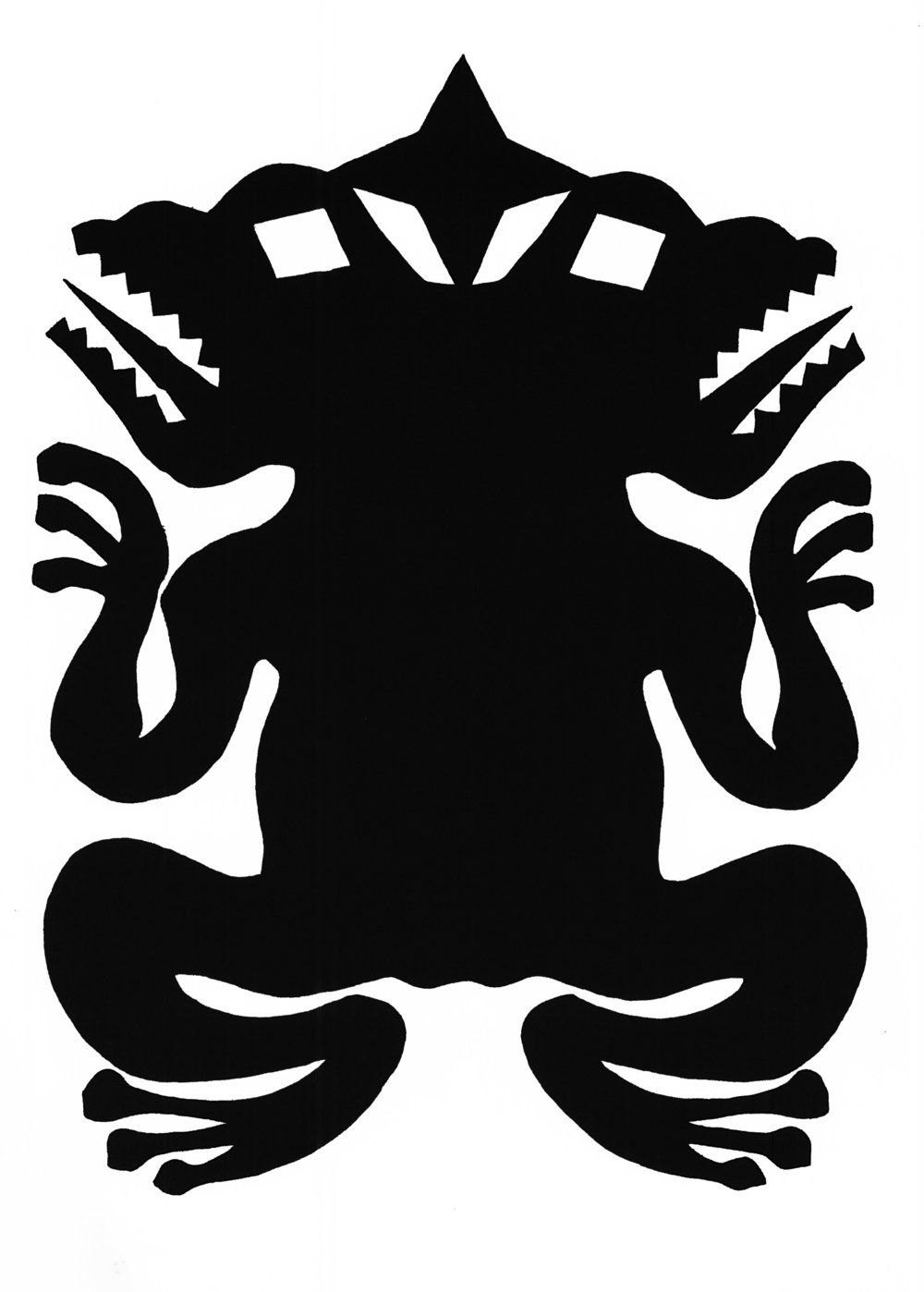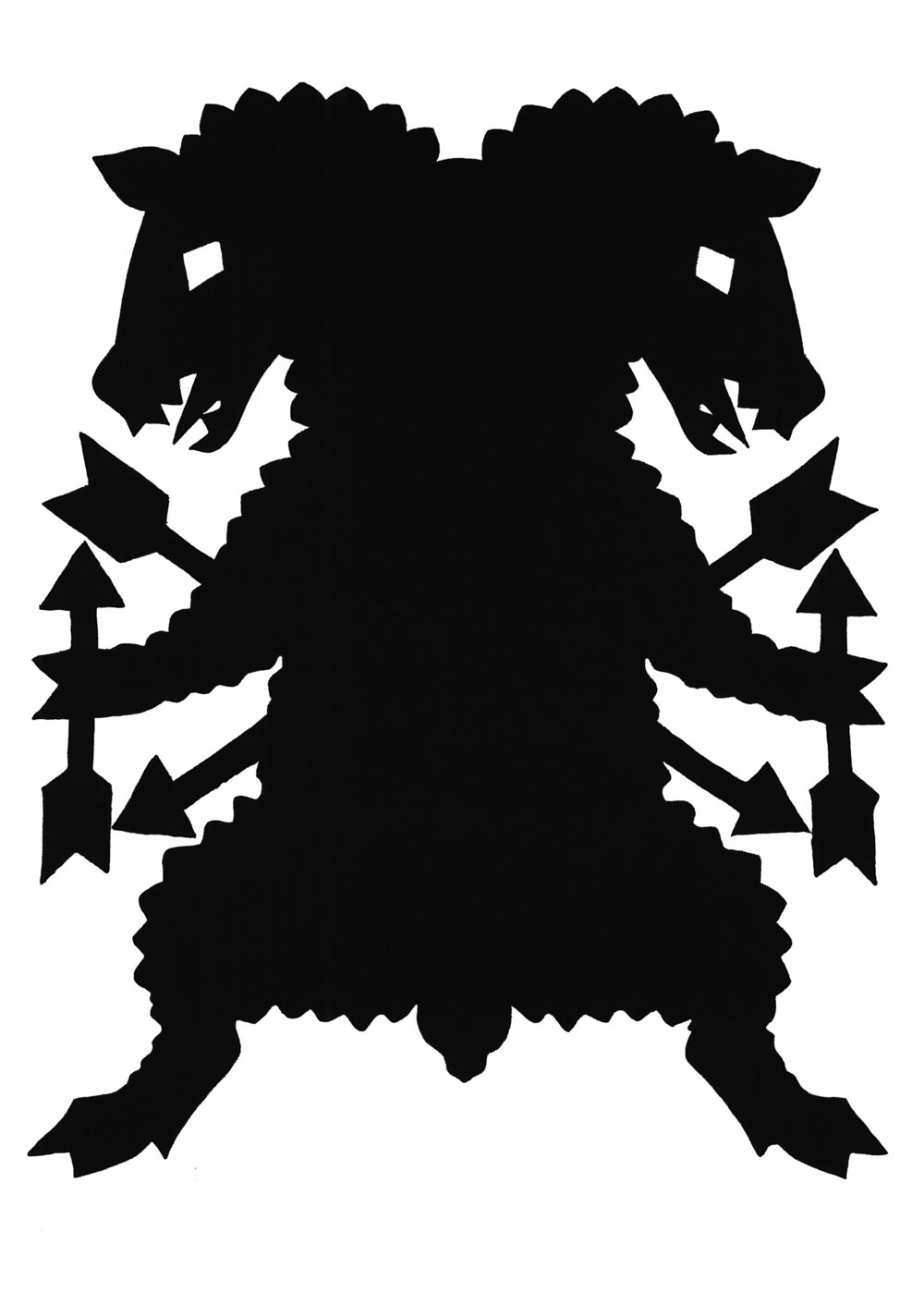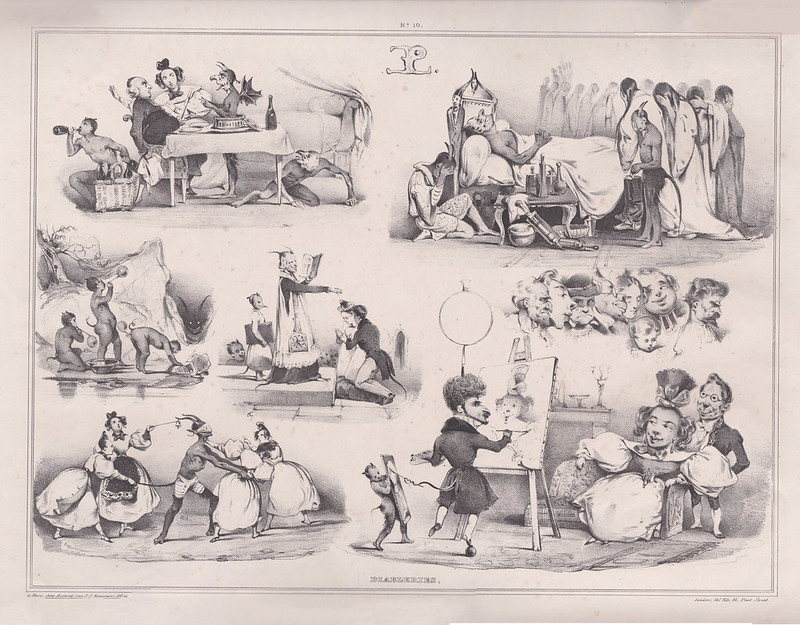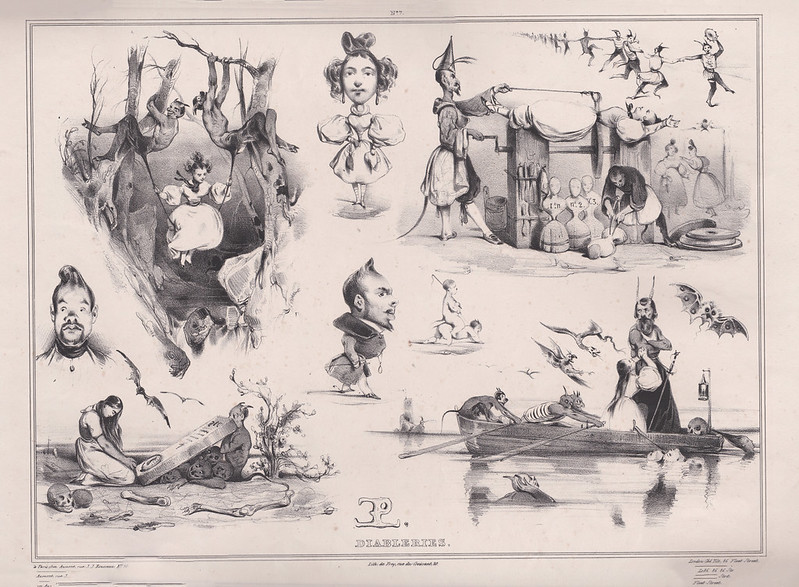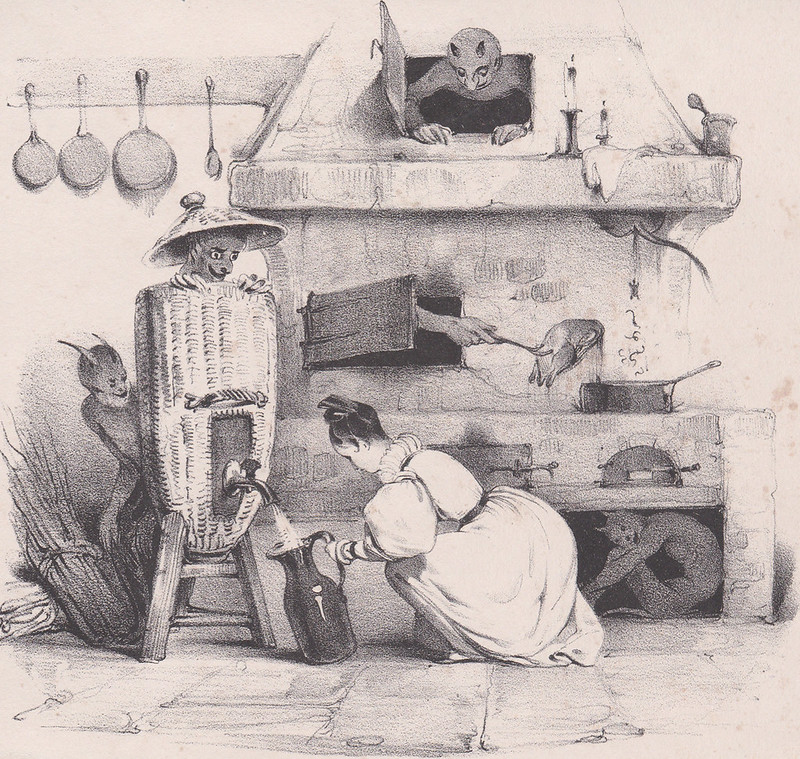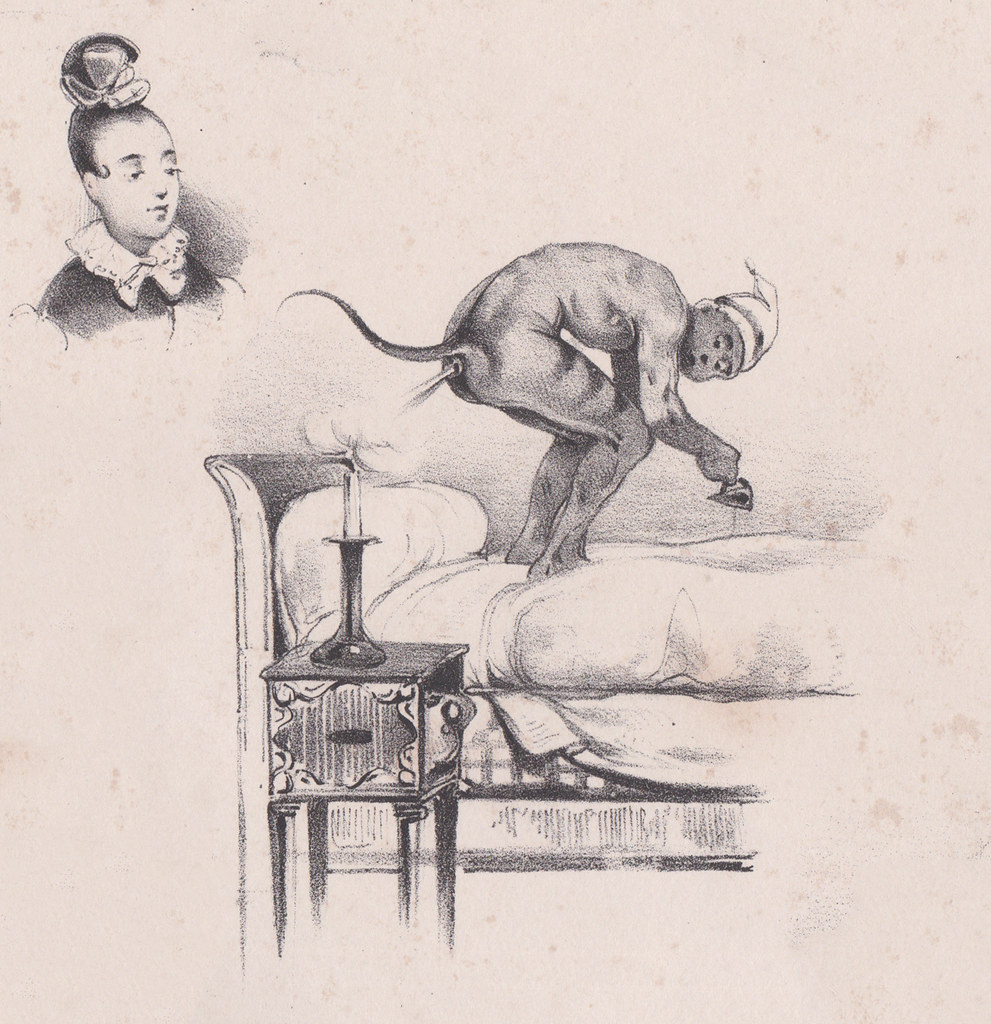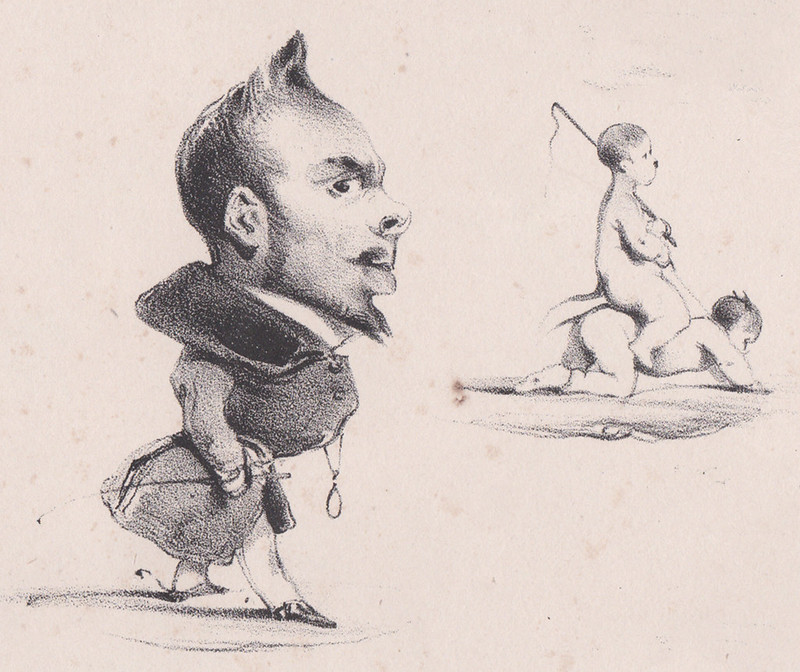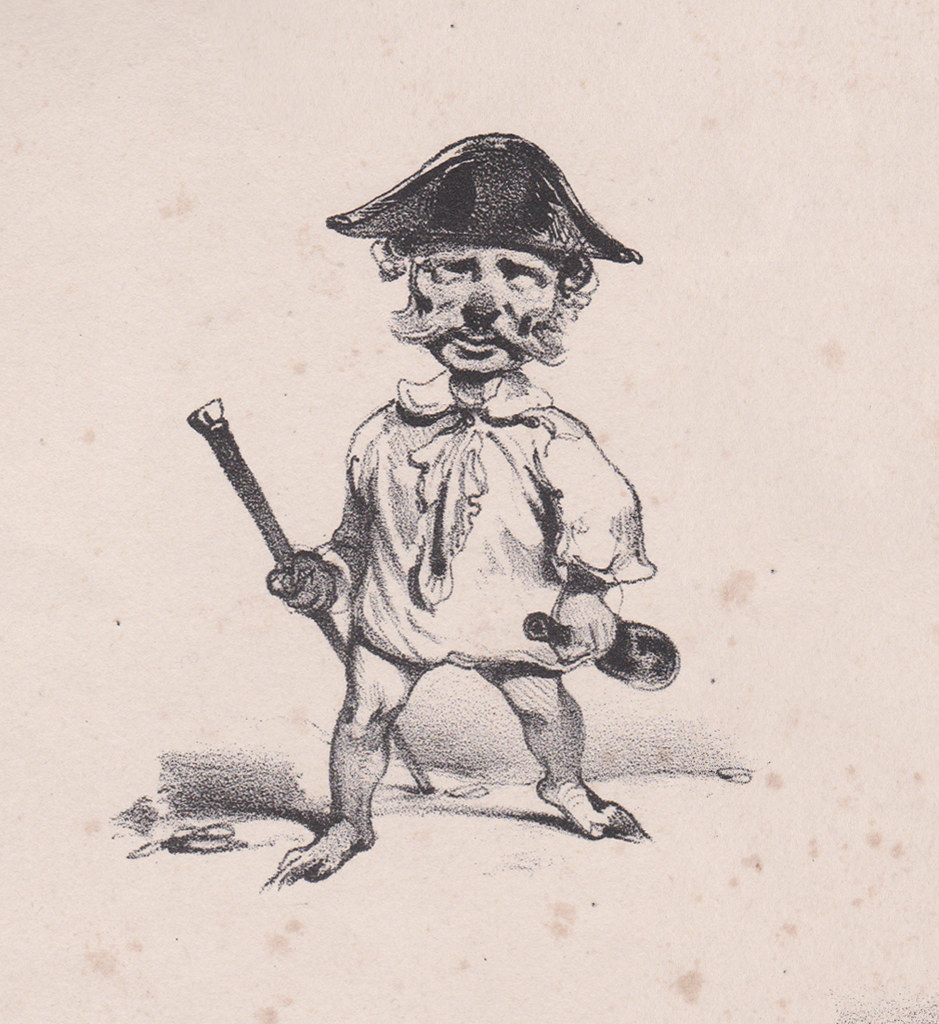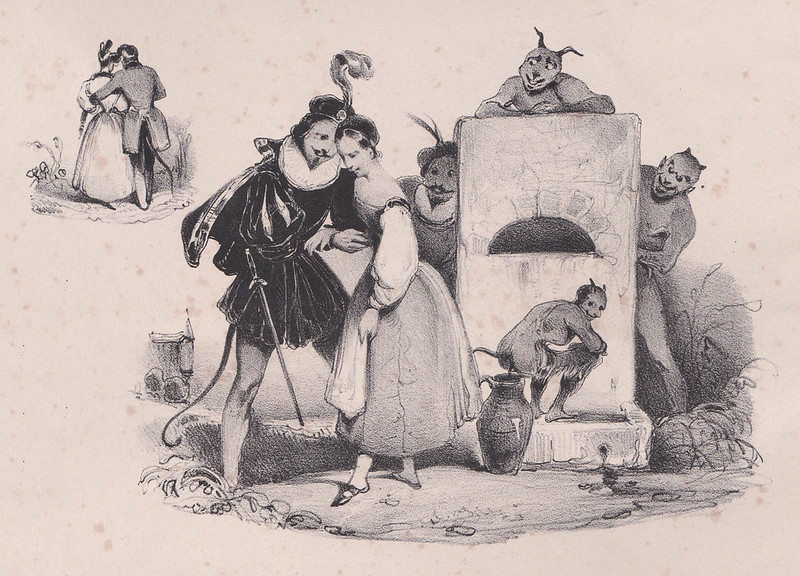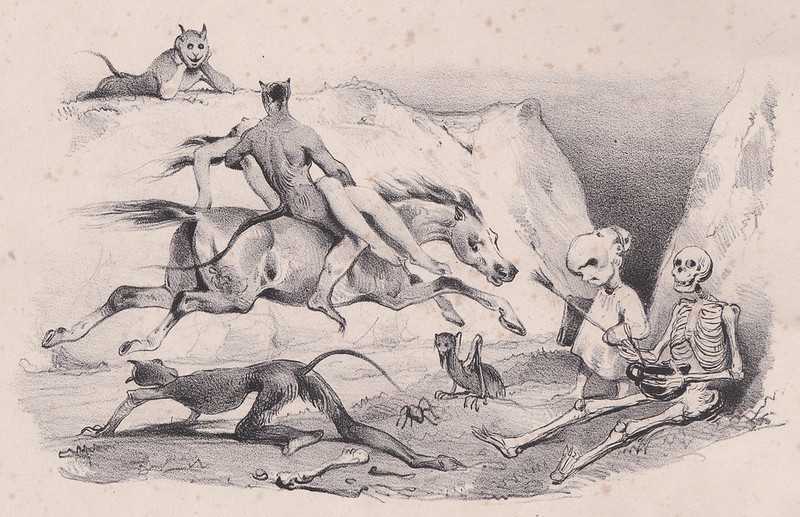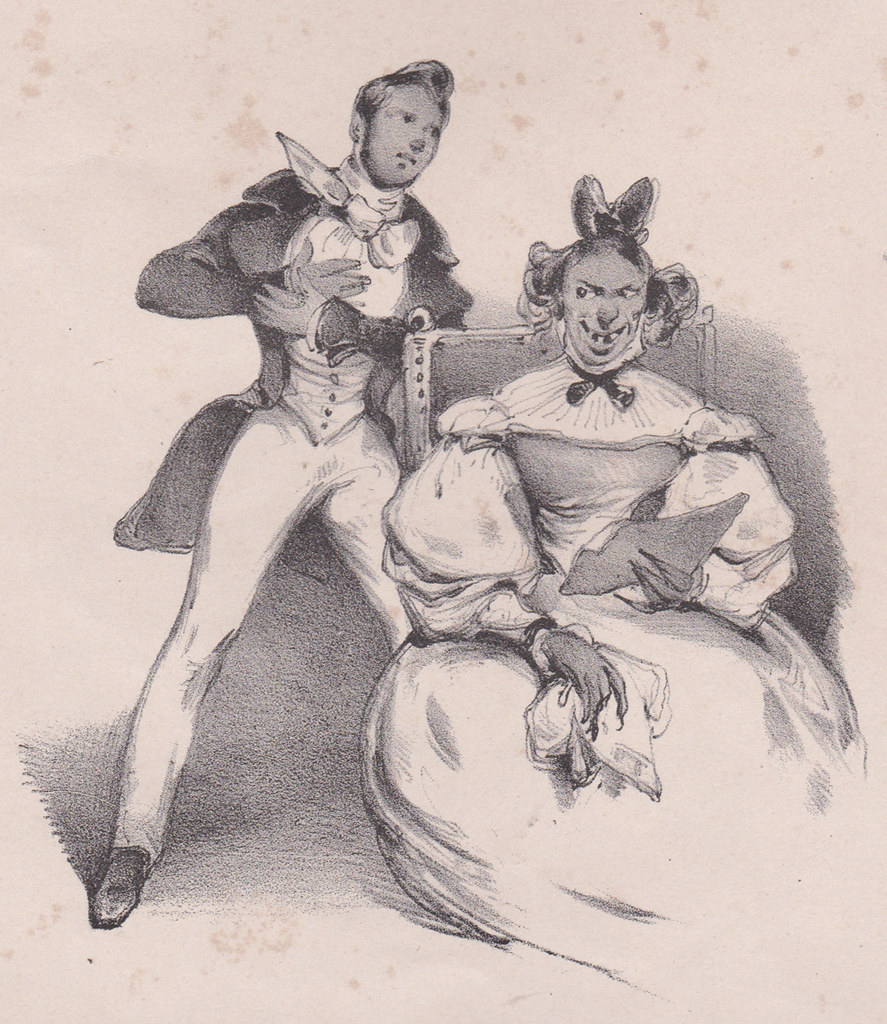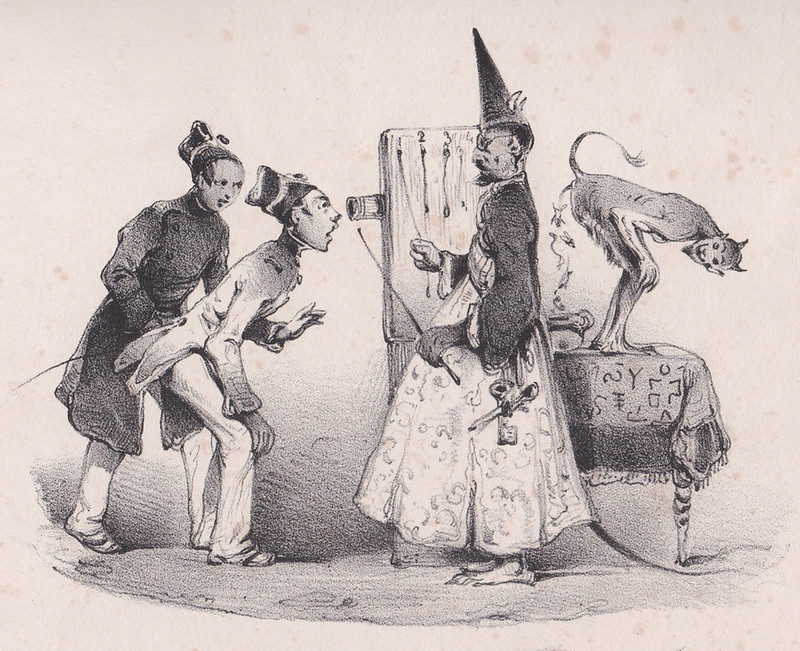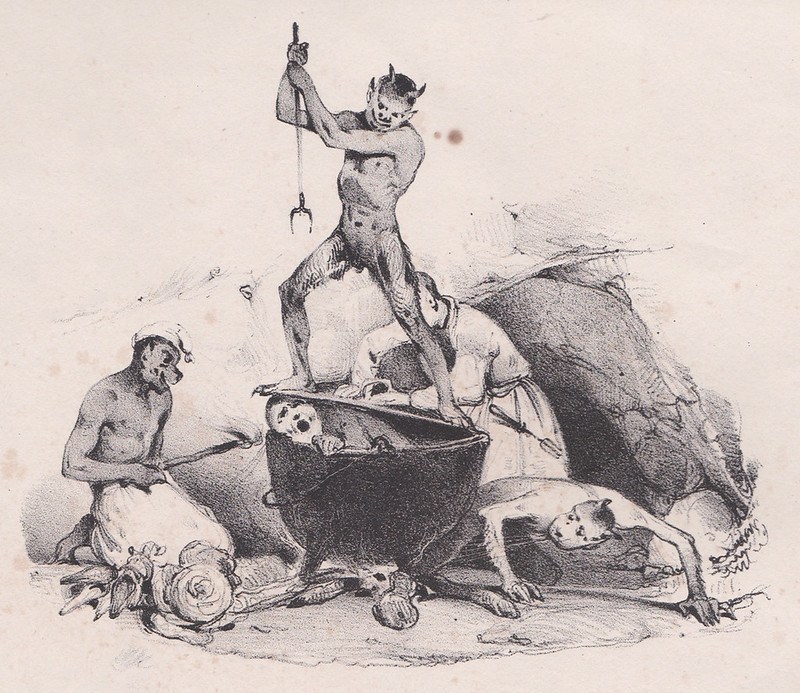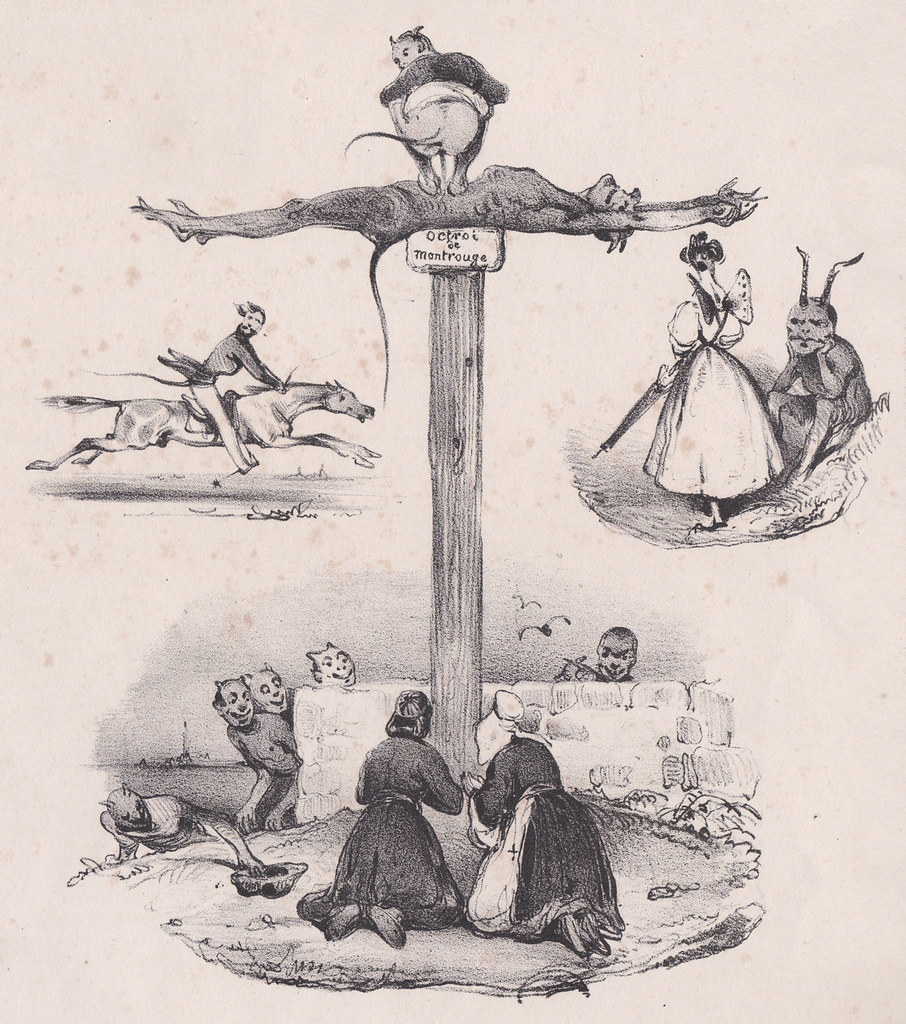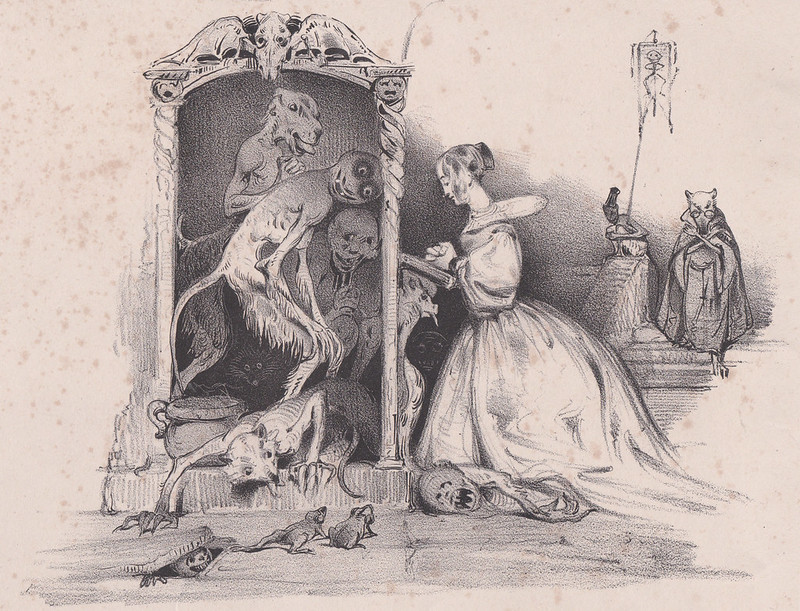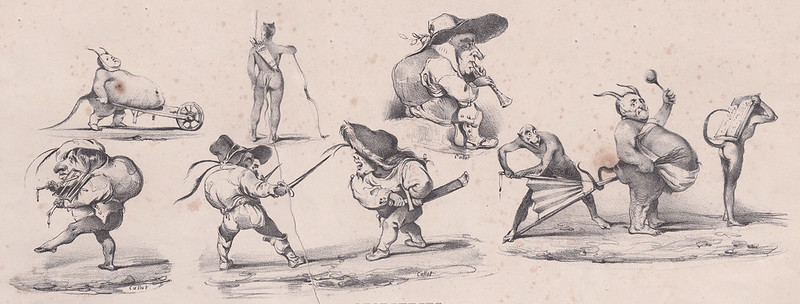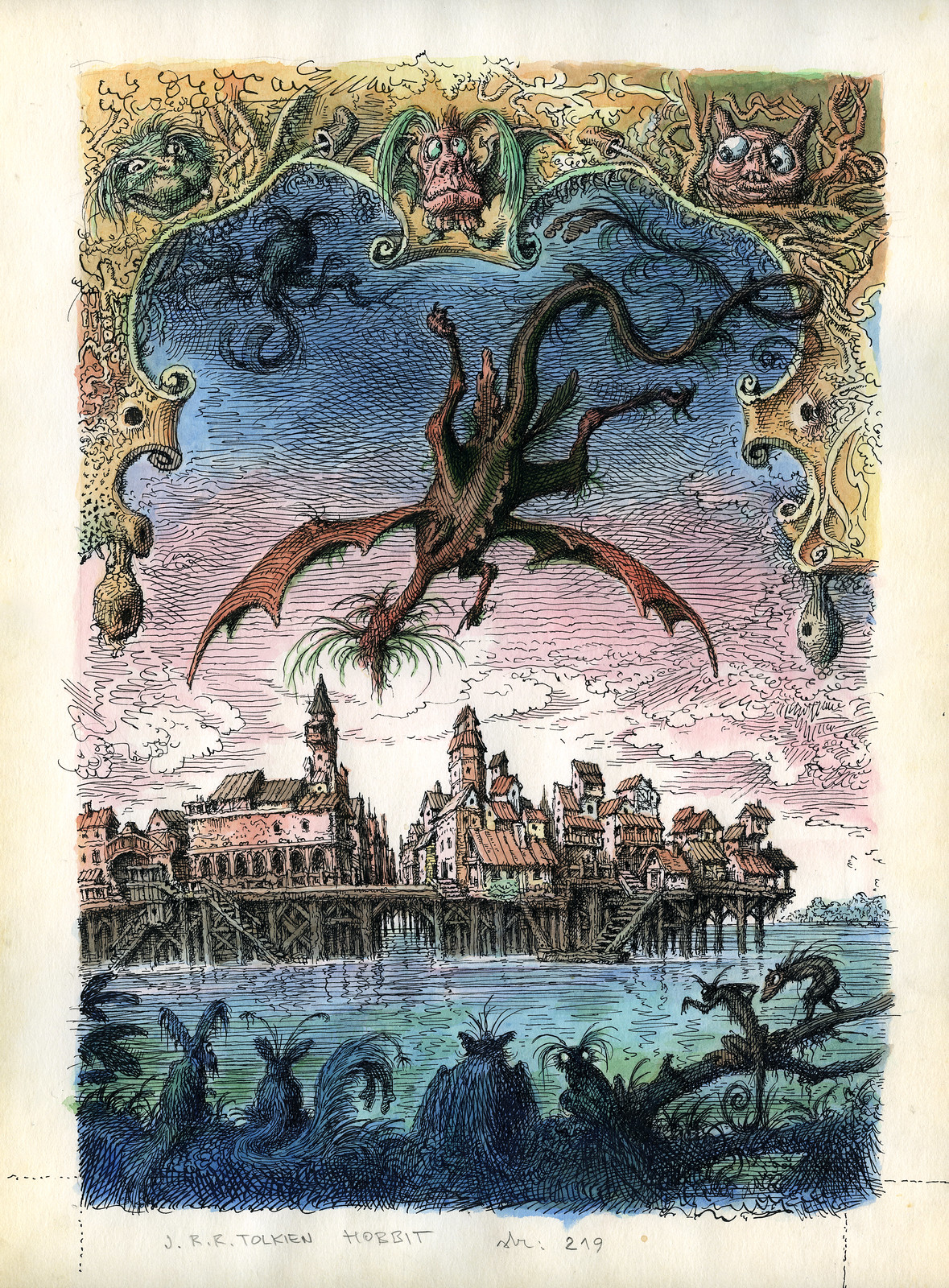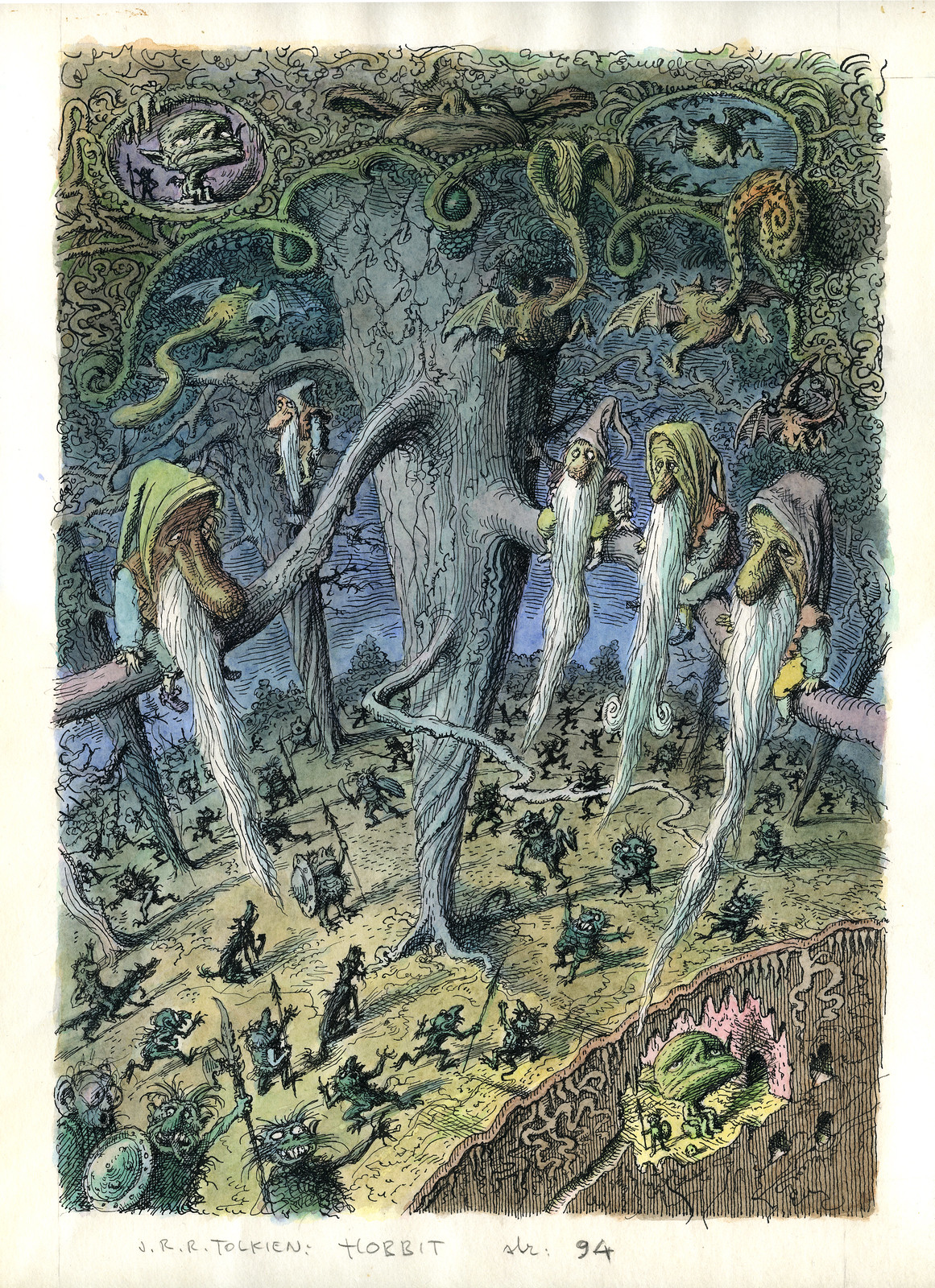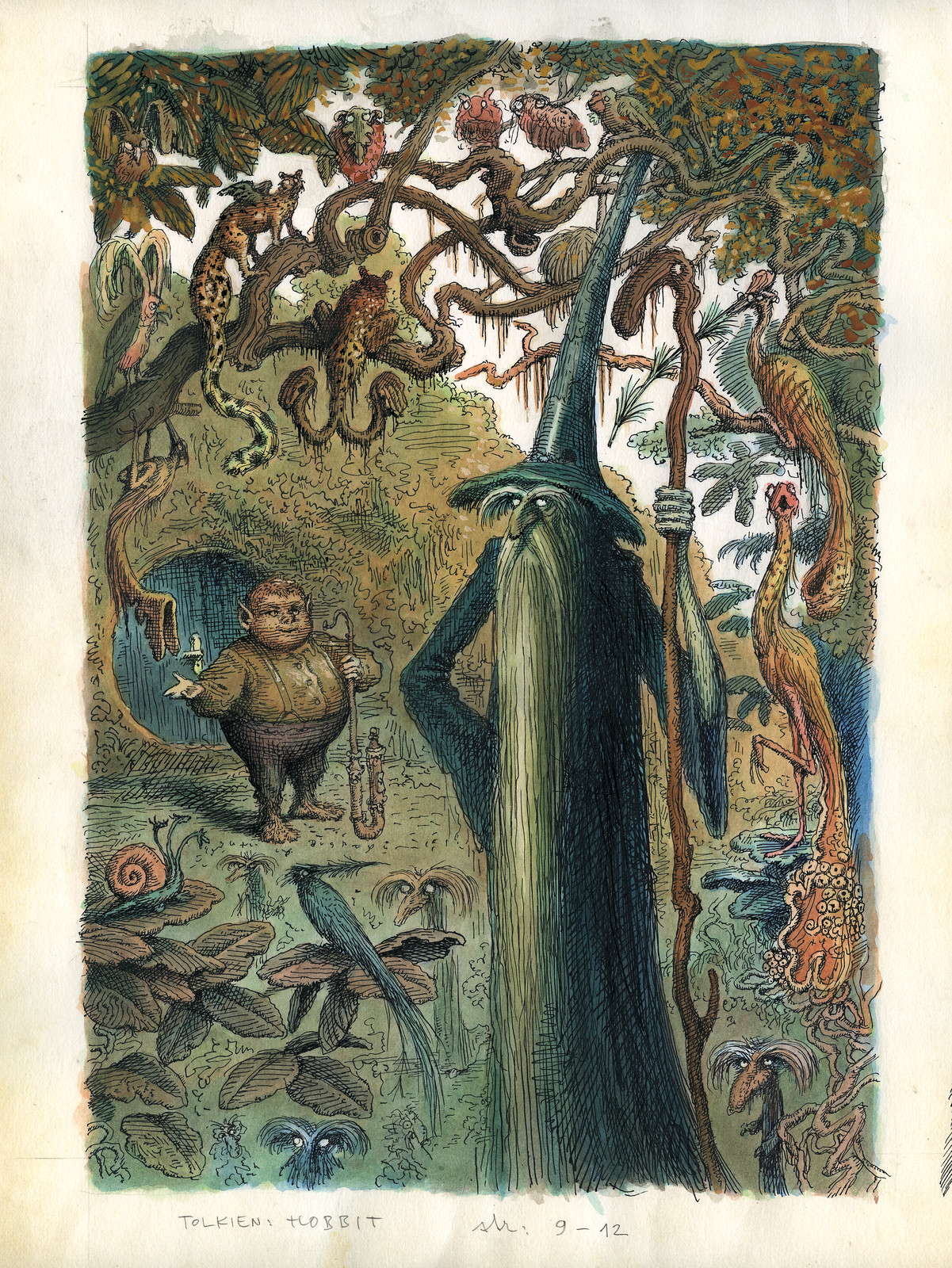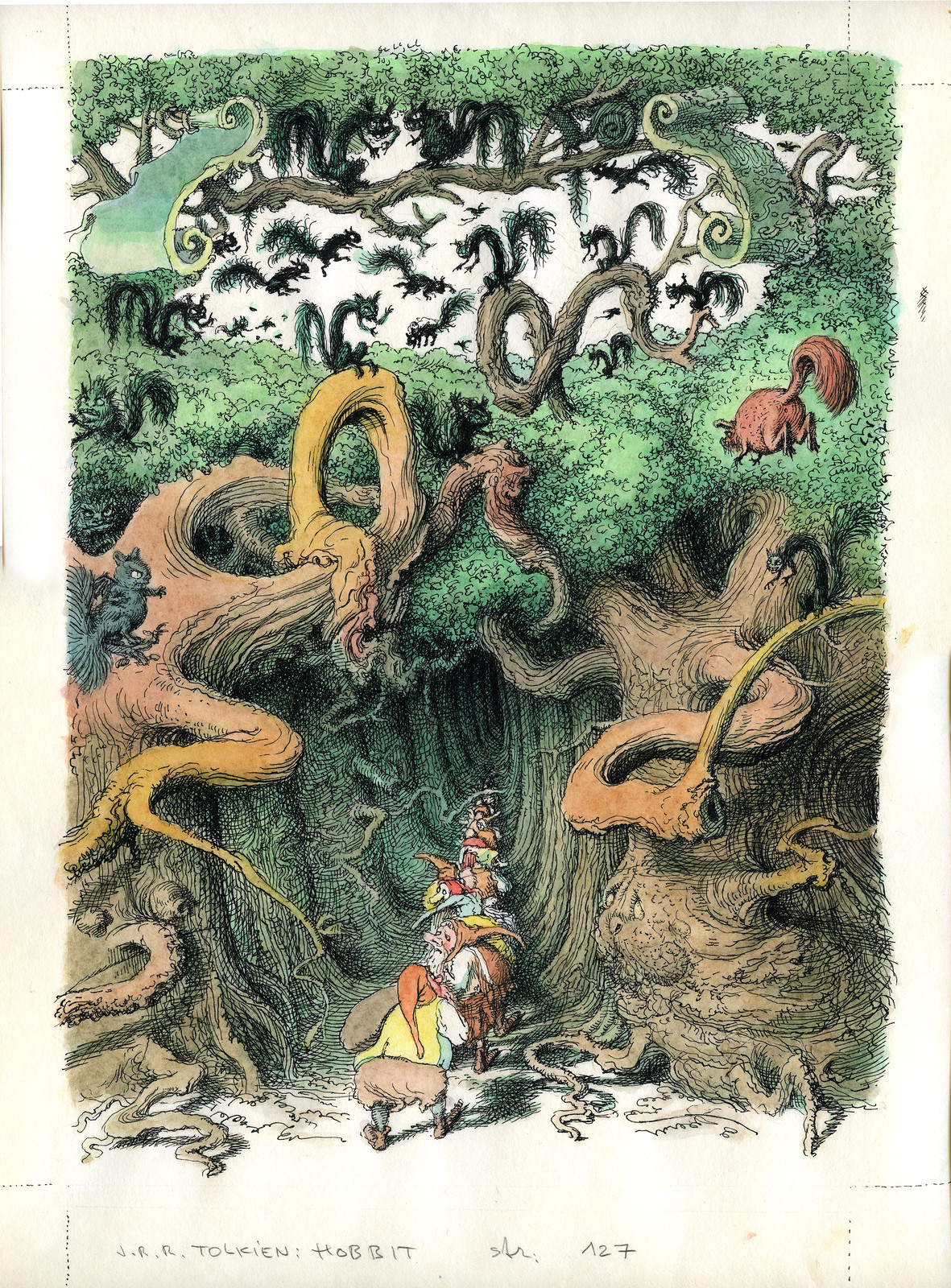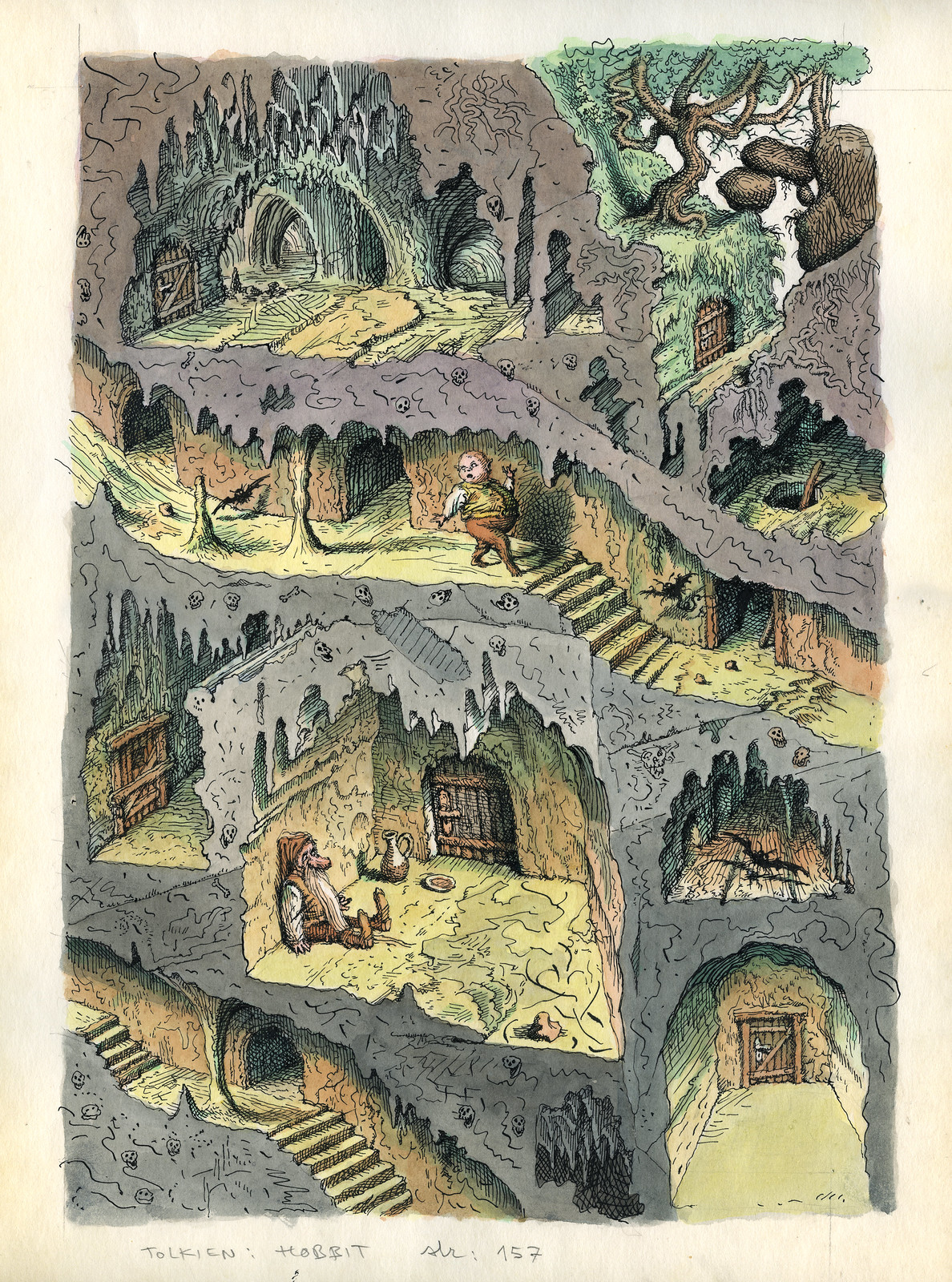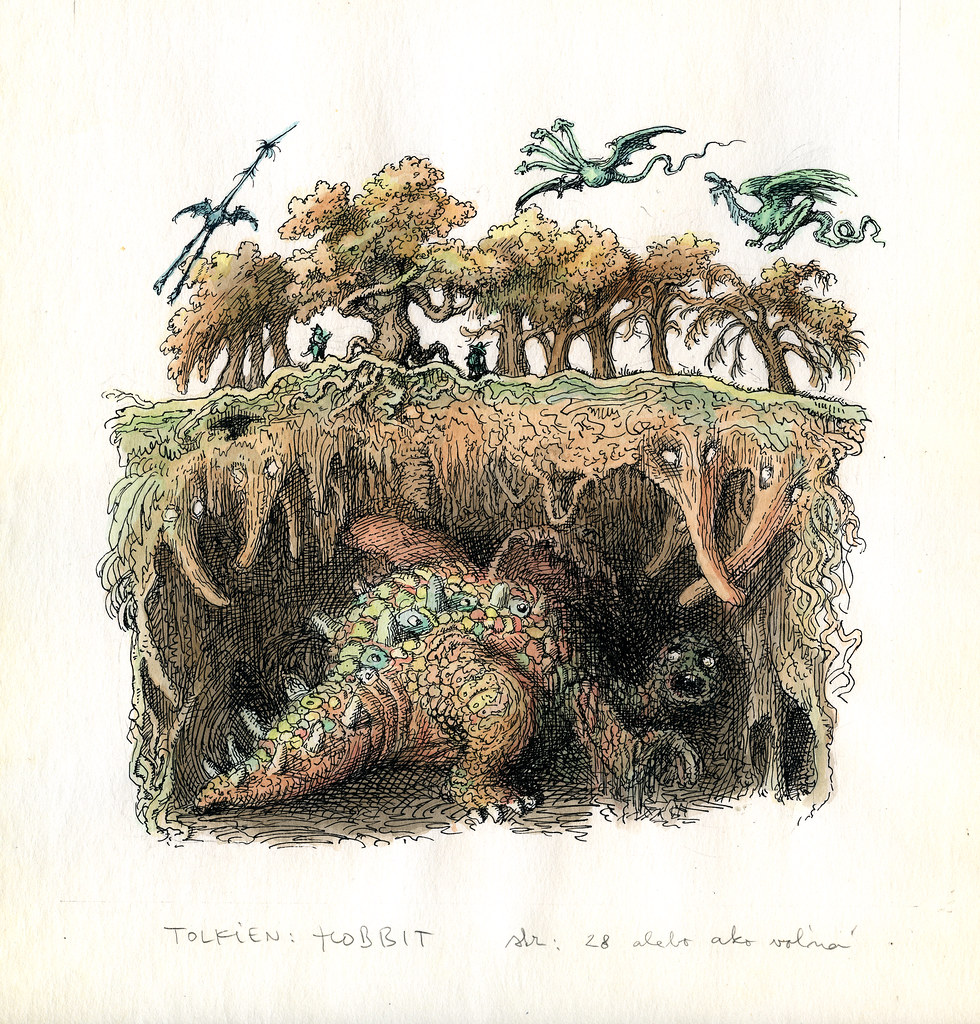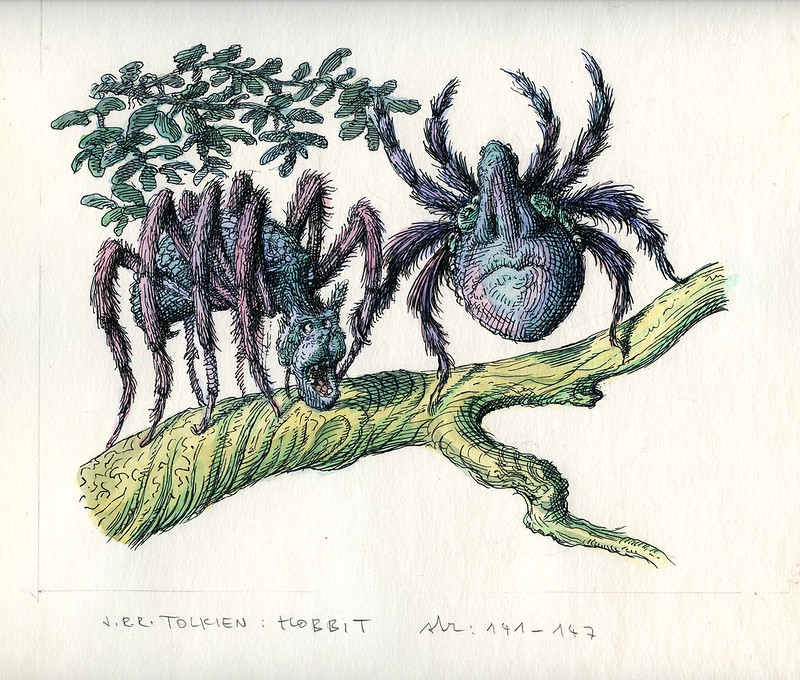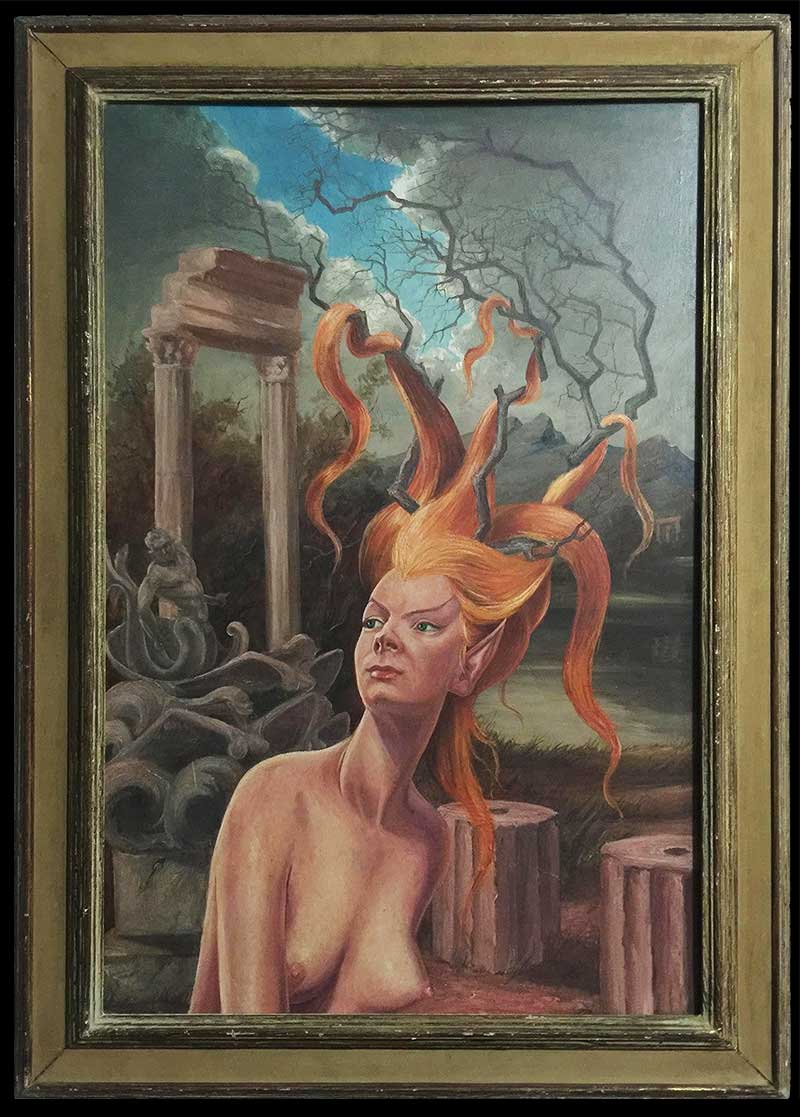
Unknown artist, found in an estate in Maine. Early 20th century, oil on canvas. The painting seems to depict a dryad, a tree nymph or tree spirit in Greek mythology. ..

Fritz Gareis (1872-1925) “the Light” circa 1920 ink and watercolor.

Andreas Cellarius Harmonia macrocosmica : sev Atlas universalis et novus, totius universi creati cosmographiam generalem, et novam exhibens 1708

Bookplate THE INFERNAL GRAND PRINCE MARBUEL. excepted from "Doctor Johannes Faust's Magia Naturalis et Innaturalis"Marbuel is the seventh grand prince of hell. He stands under the planet, his regent is called Gabriel, a Throne angel of the Holy Jehova. He appears early on Mondays at 1, 4 and 9 o’clock, but at night at 10 and 12 o’clock in a human form with a grey cowl and holds a key in his hand.Excepted from "Magia Naturalis" 1848.full illustration
here
Iconic Devil Andirons circa 1930’s, flame cut steel

M.A. Smith "Last Reveilie" circa 1950's made in a V.A. Hospital.



Unknown artist , Germany circa 1900 "Execution of a Witch" Oil on Canvas with handmade painted frame.

Unknown artist , Germany circa 1900 "Execution of a Witch" Oil on Canvas detail.

Unknown maker, Masonic Birdhouse, painted wood, circa 1940's

Unknown maker, Masonic Birdhouse, painted wood, circa 1940's

Unknown Maker, Midwestern USA, circa 1880 - 1900 Arc of the Covenant Angels, Handcarved and polychromed wood,

Unknown Maker, Midwestern USA, circa 1880 - 1900 Arc of the Covenant Angels, Handcarved and polychromed wood,

Unknown Maker, "Venus", date unknown, Plaster cast of Venus De Milo, red velvet, hand carved frame. Found in an abandoned lodge in Michigan in the 1950's, possibly a
Rebekahs lodge. This work was included in the show "NO STARS: A Twin Peaks Tribute Exhibition" in NYC
in October 2019.
Hermon Finney. Eve With Serpent. Plaster with paint. circa 1950's.

Unknown artist, Illustration, possibly for pulp magazine, circa 1940's, Ink and Gouache on carboard.

Aeron Alfrey “Gorgon Scrambler” Ink on paper 2017

Erna Kd (Indonesia) "The Sorceress" ink on paper 2015

Alex Kuno Untitled Pencil on paper 2016

John Everard “ADAM'S FIFTH RIB” 1935 Photogravure

Walter Bird "Devil Dancer" photogravure 1930

Jaya Suberg Untitled 2019 photgraph

Alexis Palmer Karl "The Serpent", production still from "The Persistence of Ritual" film, 2019 photograph

Dolorosa De La Cruz "Invocation of la Reina Roja 2" 2014 gouache pencil and gold ink

Soey Milk "Propinquity" Pencil and watercolor 2014

Aurore Lephilipponnat “William Mortensen Inspired” 2017 pencil on paper

Eldon Garnet “NO.” #3 1997 Chromogenic Color Print

Lacaze Théophile Diablerie Demons Writer Baudelaire 1839, pencil

Unknown maker, American, ceramic Devil, circa 1940's

Unknown photographer, Mourning Woman, circa 1875.

1929 Press Photo Mourning 1920s Women Dressed in Black Madame Foch France

Large Painted photograph Victorian Woman in Mourning circa 1875

Keystone View Company, 1894

Press photo 1949, London

Ken Weaver "It Was Eternity That Reached Out First" 2019 Daguerreotype printed on aluminum

Studio photograph 1923

Unknown photographer, Vernacular snapshot, circa 1940's

Original Lobby card Virgin Witch (1972) Director: Ray Austin

Bookplate American medical journal, after De Monstris, 1865

Inge Vandormael "Offering" 2018 pencil on paper

Dan Barry “Krampus” 2015 antique frame, found paper, graphite, elmers glue

India Evans "Cosmic Connection" 2016 Mixed media collage

Eddie Adams Desciple of Bhagwan Shree Rajneesh 1979, Poona, India.

Unknown photographer, "Devotee of a Witchcraft Cult in Brazil", 1956, Silver print.

Unknown photographer "Native Tibetan Devil Dancers with Masks, Lamas" 1910, postcard.

Burt Shonberg (1933 - 1977) "Edith (I should have Loved you Better)" 1958 Casien on panel.

H. Freitag, Germany 1939, watercolor.

Unknown artist (Niko Lucassem) "Tanzteufel" (Dancing Devil), 1948 pastel on black paper

Unknown Maker, American, circa early 1900's "devil and Dancer", carved and polychromed wood.

Emily Andersen "Enter 3 Witches" 1944 Oil on canvas

Unknown maker, WW2 War Painting with Satan, gouache, circa late 1940's early 1950's.

H.C. Evans & Co. Devil Freak Show Banner Remnant. early 20th century

Pipe Rack with Lincoln Imp, carved and painted wood with ornamental metal attachments, c. late 1800's.

Pipe Rack with Lincoln Imp, carved and painted wood with ornamental metal attachments, c. late 1800's.

Luciana Lupe Vasconcelos “Anatomy of Madness” 2018

Tiffany Hsiang “Manatee” 2016 pencil on paper

Unknown artist, Group of 9 watercolors depicting shrunken heads, British, circa 1940's

Unknown artist, watercolor depicting shrunken head, British, circa 1940's

Unknown artist, watercolor depicting shrunken head, British, circa 1940's

Romeyn de Hooghe (1645 - 1708): bookplate from “Hieroglyphica — Symbols of Ancient People” 1735. MYTHOLOGY-ICONOLOGY-EVIL-HYROGLYPHIC
Plate 28 shows evil Gods. This plate shows A. Herimis; B. Joosje Tidebaic; C. dragon; D. Abaddon; E. Temptation in the Garden of Eden; F. treasure keeper; G. treasure guard; H. goblins; I. pagan dance; K. De Witte Vrouw (the White Lady); L. Larunda; M. Harpies; N. Wrath of the harpies; O. Nightmare; P. Earthquake; Q. Scylla; R. Charybdis; S. Syrtes.
Full series
here
Bookplate, Illustration from "Oeuvres diverses de M. de Fontenelle." 1728

Bookplate, excerpt from Scheible, J. (ed.) "The Flying Leaves of the XVI. and XVII. Century, in so-called one-sheet prints with engravings and woodcuts, first from the field of political and religious Caricature"

Olga Fröbe-Kapteyn, “The Grail”, screen print, circa 1930.Full series
here
Unknown Maker, Hand Painted Serpent Mirror, late 1800's, American.

Unknown Photographer "THH GHOST" circa 1880 - 1900 Glass plate negative with wax paper wrapping with pencil.

Unknown Photographer "THH GHOST" circa 1880 - 1900 Glass plate negative.

Unknown Photographer "THH GHOST" circa 1880 - 1900 Print from glass plate negative.

John Godwin "Anton Szandor LaVey" 1972

Nyahzul C Blanco "Starman" from the exhibtion
"Saint Bowie" at Stephen Romano Gallery

Manuscript page depicting demons in Hell Rajasthan, India, early 20th century

Cynthia Marshall (1945 - 2018) "Venus" undated, Acrylic on canvas

W.M. Morris "Judgement Day", American 1924, Oil on canvas.






Masonic funerary ceremonial taxidermic bird, circa 1875 - 1880. Found in midwestern lodge, in a handmade glass case.


Photograph of Masonic funerary ceremonial taxidermic bird, circa 1875 - 1880. Found in midwestern lodge.

Colin Christian "Teeth" 2015

Colin Christian "Alive" 2015

Unknown photographer, Vernacular snapshot, circa 1950's

Unknown photographer, Vernacular snapshot, circa 1940's

Unknown photographer, Vernacular snapshot, circa 1940's

Unknown photographer, Vernacular snapshot, circa 1940's

Unknown photographer, Vernacular snapshot, circa 1940's

Unknown photographer, Vernacular snapshot, circa 1930's

Unknown photographer, Vernacular snapshot, circa 1940's

Japanese erotic snapshot 1940's

Unknown photographer, Vernacular snapshot, circa 1930's

Unknown photographer, "ELECTROPLASM"©, Vernacular snapshot, circa 1930's
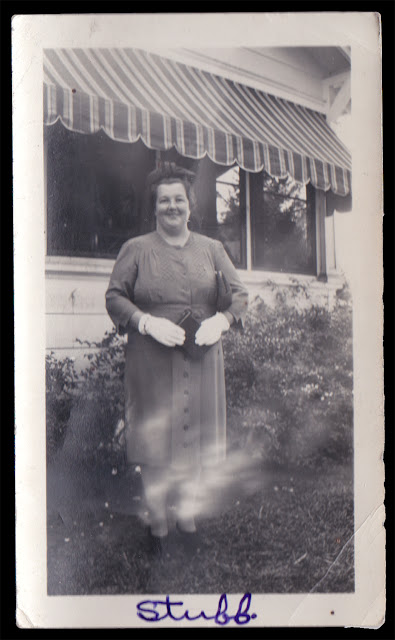
Unknown photographer, "ELECTROPLASM"©, Vernacular snapshot, circa 1930's

Unknown photographer, "ELECTRORB",© Vernacular snapshot, circa 1930's

Unknown photographer, Vernacular snapshot, 1941

Unknown photographer, "Seance" vernacular snapshot, circa 1940's

Unknown photographer, Vernacular snapshot, circa 1930's

Unknown photographer, Vernacular snapshot, date unknown

Unknown photographer, Vernacular snapshot, circa 1940's

Unknown photographer, Vernacular snapshot, circa pre1940's

Unknown photographer, Vernacular snapshot, 1949.

Unknown photographer, Vernacular snapshot, circa 1920's

Unknown photographer, Vernacular snapshot, circa 1930's

Unknown photographer, Vernacular snapshot, date unknown

Unknown photographer, Vernacular snapshot, date unknown

Unknown Artist, American, Watercolor depicting "9th Circle Treachery" of Dante's Inferno

Unknown Artist, American, Watercolor depicting "Geryon Leading Dante To The 8th Ring Of Hell" of Dante's Inferno

Unknown Artist, American, Watercolor depicting "Virgil At The Entrance Of Hell" of Dante's Infernofull series
here
Man with Skull and Open Book photo-postcard c. 1900

ODD Fellows Banner, c. 1880, Texas.

Bookplates illustrating the works of Jacob Bohme 1665
More images
here
Jen Bandini “The Black Lodge” 2019 ink on paper

Japanese Vernacular photograph 1940's depiction vampiric woman

Unknown Maker, circa 1940's "The Black Stag" Carved and polychromed wood, antlers.

Unknown Maker, circa 1940's "The Black Stag" Carved and polychromed wood, antlers.

Unknown maker, "The Venus of Detroit", 1940's, African American Fertility figure found in Detroit Michigan. carved and painted wood. More views
here.

Kim Bo Yung "Sentinel" 2015 ink and watercolor on paper.

Ceremonial Wand, Boston MASS c. 1800 Carved and inscribed Scrimshaw bearing the inscription "AMASARAC" the demon entity possessing magical and transformative powers over spices and herbs. Presumably this wand was used to handle such spices and herbs during ceremony, while conjuring AMASARAC to empower them.



Unknown Photographer, "Woman with Tiger Mask" circa 1930's

Unknown photographer, "Nude with Devil Mask" circa 1940's, photograph

Leonard Frontinak Tiger painting. Exhibited "Opus Hypnagogia" Morbid Anatomy Museum

Unknown Photographer Veiled Woman with Shrunken Demon Head. circa 1920's, Photograph

William Hope, Group of 3 spirit photo, photo postcards, 1920's

Jack Edwards, Spirit photograph at Camp Silver Belle PA, circa 1940's.

Jack Edwards, Spirit photograph at Camp Silver Belle PA, circa 1940's.

Robert Boursnell Spirit photographer circa 1900

Falconer Brothers Spirit Photographers circa 1930

Édouard Isidore Buguet, Spirit Photograph of Madame and the materialization of Allan Kardek May 28 1874. Kardek was the founder of the " Revue Spirite" Part of the message of the sign reads: "Amis, continues propager notre doctrine, adieu pour toujours" "Friends, continue to spread our doctrine, goodbye forever"

Apocalyptic Painting by unknown maker (signature illegible) circa 1940's, Midwestern American Unknown medium, probably enamel or house paint.

Pair of Apocalyptic Paintings by unknown maker (signature illegible) circa 1940's, Midwestern American Unknown medium, probably enamel or house paint

A. Fiorello (dates unknown) "The Right To Arm Is The Right To Kill" circa 1960 - 1970 painted plaster relief

A. Fiorello (dates unknown) "Behold the Profit-Patriots & Their Greed-Power Guardians " circa 1960 - 1970 painted plaster relief

A. Fiorello (dates unknown) "Duality Of Extremes" circa 1960 - 1970 painted plaster relief

Wolfgang Grasse "The Broom" ink on paper 1981

Ray Harryhausen (1920-2013) - Oil on board painting from the estate sale in 2015, possibly used for reference for Sinbad, Ray Harryhausen in pencil on reverse of frame, framed, 23 x 36 inches

Wolfgang Grasse "Dresden" 1977, Acrylic on panel

Wolfgang Grasse "The Throne of Death" 1999 Acrylic on panel

Wolfgang Grasse "The Kingdom of Death" 1999 Acrylic on panel

Wolfgang Grasse (1930 - 2008) "The Fallen Angel of Love or Sodom and Gomorrah" 1999

Wolfgang Grasse (1930 - 2009) "South East Garden". 2000, Acrylic on panel. Depicts Jiutian Xuannü, the Chinese goddess of war, sex, and longevity.





Charles A.A. Dellschau (1830 - 1923) "Aero Bomba" 1921 Further images
here
Charles A.A. Dellschau (1830 - 1923) "Goose" 1898

Charles A.A. Dellschau "Aero Myo" 1918

Charles Dellschau "Sky Lubrication" 1920

William Mortensen "Mort De Guillaume" (Death of William). Depiction of William the Conquerer being lowered into his tomb. 1935, photograph
William Mortensen (January 27, 1897 – August 12, 1965) was an American photographic artist, who first gained acclaim for his Hollywood portraits in the 1920s in the Pictorialist style and later for viscerally manipulated photography, often touching on themes of the occult.
www.williamortensen.com
William Mortensen (1897 - 1965) "The Initiation of a Young Witch" Photograph 1928

William Mortensen (1897 - 1965) "The Old Hag with Mask" Photograph 1928

William Mortensen (1897 - 1965) "The Old Hag with Incubus" Photograph 1928

William Mortensen (1897 - 1965) "The Old Hag" Photograph 1928

William Mortensen (1897 - 1965) "Preparation For The Sabbath" Photograph 1928

William Mortensen (1897 - 1965) "The Sorceress" Photograph 1928

William Mortensen (1897 - 1965) "The Sorceress" Photograph 1926

William Mortensen (1897 - 1965) "Courtney Crawford with Masks" Photograph 1926

William Mortensen (1897 - 1965) "Faye Wray with Masks" Photograph 1928

William Mortensen (1897 - 1965) "Balphagor and the Lost Souls"1928 Photograph

William Mortensen (1897 - 1965) "The Schrapnel" 1929 Photograph

William Mortensen "The Heretic" 1926 Photograph

William Mortensen (1897 - 1965) "Circe" 1932 Photograph

William Mortensen (1897 - 1965) "Self Portrait with Courtney Crawford" 1926 Photograph

William Mortensen (1897 - 1965) "The Elemental" (also titled "A Hindoo Woman") 1928 Photograph

William Mortensen (1897 - 1965) Untitled ("Saint Courtney") 1926 Photograph

William Mortensen (1897 - 1965) "The Old Hag" 1926 Photograph

William Mortensen (1897 - 1965) "Victory Ball" 1926 Photograph

William Mortensen (1897 - 1965) "Madame de Pompadour" 1926 Photograph

William Mortensen (1897 - 1965) "Hypatia" 1926 Photograph

William Mortensen (1897 - 1965) Untitled 1926 Photograph

William Mortensen (1897 - 1965) "Nicolo Paganini (The Devil's Violinist)" 1934 Photograph

William Mortensen (1897 - 1965) "Jezebel" Photograph 1928

William Mortensen (1897 - 1965) "Isis" Photograph 1928

William Mortensen (1897 - 1965) "The Witch Lady Morgan y Dylwythen Deg" Photograph 1926

William Mortensen (1897 - 1965) "The Witch Lady Morgan y Dylwythen Deg" Photograph 1926

William Mortensen (1897 - 1965) "The Witch Lady Morgan y Dylwythen Deg" Photograph 1926

William Mortensen (1897 - 1965) "The Tantric Priest" Photograph 1932

William Mortensen (1897 - 1965) "Madame LaFarge" Photograph 1934

William Mortensen (1897 - 1965) "The Heretic" or "A Spider Torture" Photograph 1926

William Mortensen (1897 - 1965) "Woman with Mask and Skull" Photograph 1926

Darcilio Lima (1944 - 1991) "The Prince" ink drawing, 1968Exhibited at Reina Sophia Museum, MadridExhibited at The Metropolitan Museum of Art, New York

Darcilio Lima, "The Magi" Lithograph, circa 1975Exhibited at Reina Sophia Museum, Madrid

Darcilio Lima, Untitled Lithograph, circa 1975Exhibited at Reina Sophia Museum, Madrid

Josh Stebbins Untitled pencil drawing 2019
Josh Stebbins on MONSTERBRAINS
Josh Stebbins "Tragedy / Devil" pencil drawing 2018

Josh Stebbins "Mortensen's Incubus" pencil drawing 2018

Kris Kuksi "Auto Cephalic Supplicating Machine" 2011 Mixed Media

Kris Kuksi "Venus Admiring Mar's Gun" 2008 Mixed media.

Kris Kuksi "Seraphim at Rest" 2015

Barry William Hale ‘Phantasma Phantasia: Milites Diaboli - [the soldiers of the Devil] Triptych” 2016 paint and marker on paper mounted on illustration board
Barry William Hale on MONSTERBRAINS
Barry William Hale "Dwellers on the Threshold" Automatic drawing Triptych, marker or paint on card, with photographic print of magical caligraphic ritual floor design. 2019

Martin Wittfooth "Entheogen" 2012 Oil on canvas

Ray Caesar "Sisters" 2005 digital media

Unknown maker, California, circa 1930's - 1940's. Group of figures, mixed media, possibly poppets used in ceremony. more details
here
Unknown maker, California, circa 1930's - 1940's. Group of figures, mixed media, possibly poppets used in ceremony.

Unknown maker, California, circa 1930's - 1940's. Group of figures, mixed media, possibly poppets used in ceremony.

Unknown maker, California, circa 1930's - 1940's. Group of figures, mixed media, possibly poppets used in ceremony.

Stewart Farrar "Alexandrian Witchcraft Initiation Ceremony of Janet Farrar (nee Owen), U.K. 1970"

Stewart Farrar "Alexandrian Witchcraft Initiation Ceremony of Janet Farrar (nee Owen), U.K. 1970"

Group of Shaman's prayer alter objects, Guatemala circa 1970's. mixed material.

Shaman's prayer alter object, Guatemala circa 1970's. mixed material.

Hans Baldung Grien "The Witches Sabbath" date unknown

Theodule Ribot (1823 – 1891) "The Witches" circa 1935

Roland Hendrickson "Season of the Witch" c. 1960. Signed photogravure

Solar Eclipse, Yerkes Observatory glass lantern slide, 1918

LE POITEVIN, Les Diables de Lithographies, 1832Full series on
MONSTERBRAINS
LE POITEVIN, Les Diables Erotique de Lithographies, 1834Full series
here
Unknown photographer, Witch photo, late 1800's, American.

Excerpted from "Vol 2 - Das Kloster" , 1845 published by Johanas ScheibleFull series
here
Jullian Baker "Knight Death and the Devil" oil on panel, 1960.

Grimoire page by an unknown hand, British, possibly 19th century, ink and unknown substance on cloth.

Grimoire page by an unknown hand, British, possibly 19th century, ink and unknown substance on cloth.

Grimoire page by an unknown hand, British, possibly 19th century, ink and unknown substance on parchment.

Grimoire page by an unknown hand, British, possibly 19th century, ink and unknown substance on parchment.

Grimoire page by an unknown hand, British, possibly 19th century, ink and unknown substance on cloth.

Grimoire page by an unknown hand, British, possibly 19th century, ink and unknown substance on parchment.

Cast bronze depiction of demon
Pazuzu. 18th century.

Mario Mercier, production still from "La Papesse" ( A Woman Possessed) 1975

Unknown photographer, "Devil and Dancer" circa 1930's

Josh Stebbins "The Patron Saint of Lost Causes" Pencil on paper 2019clockwise Wolfgang Grasse, Rosaleen Norton, William Edmondson, Henry Darger,Charles Dellschau, Darcilio Lima. Center Stephen Romano. Based on the concept of a spirit photograph.
 about Stephen Romano
about Stephen Romano
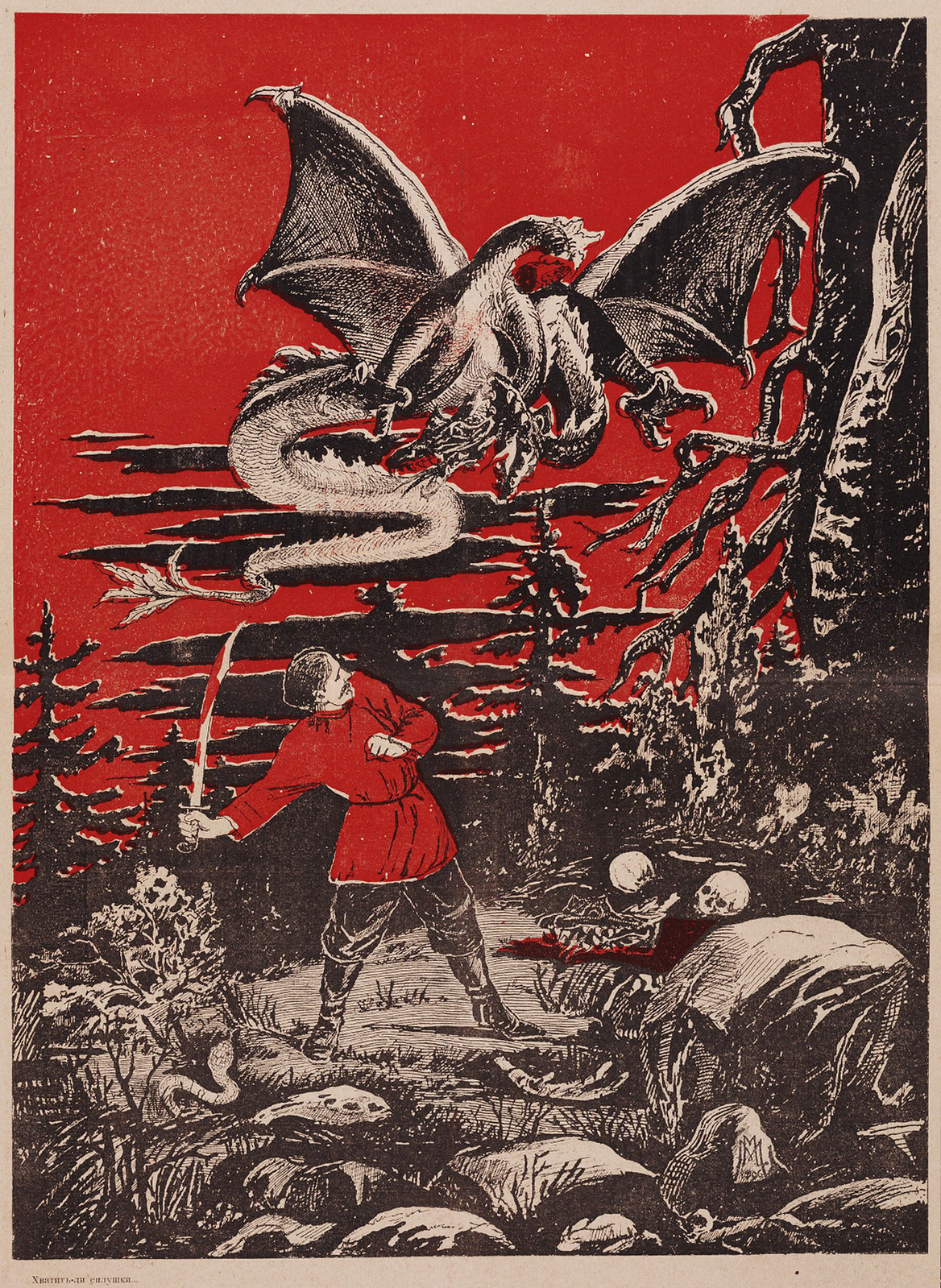
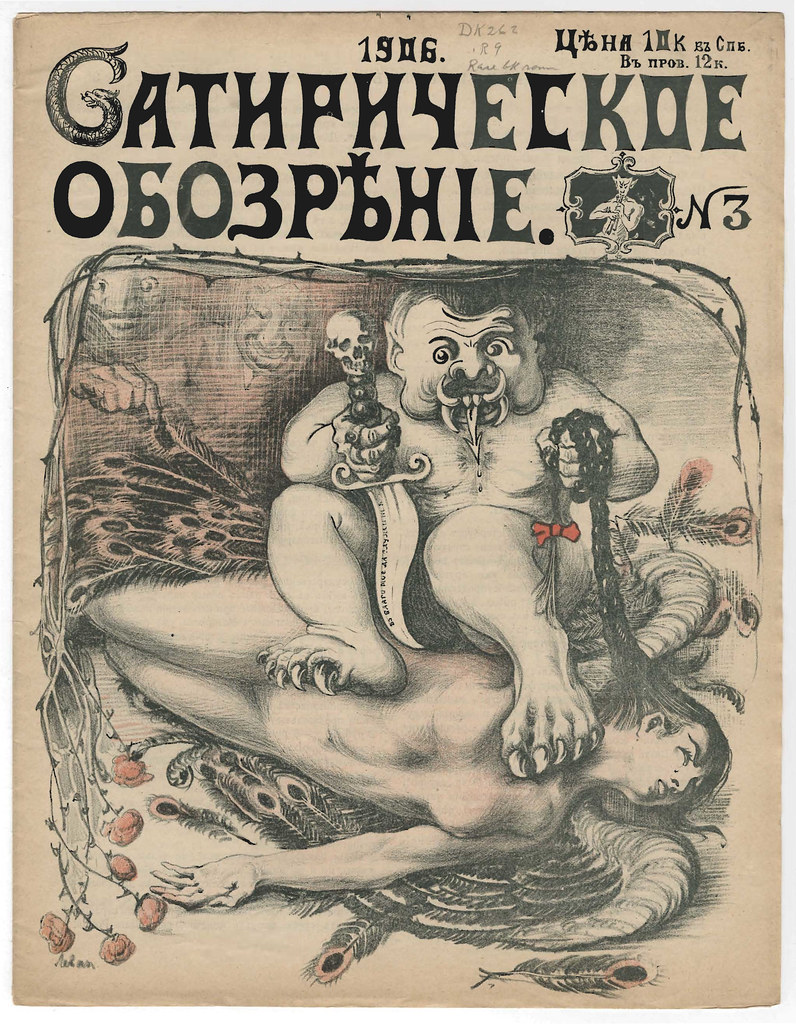
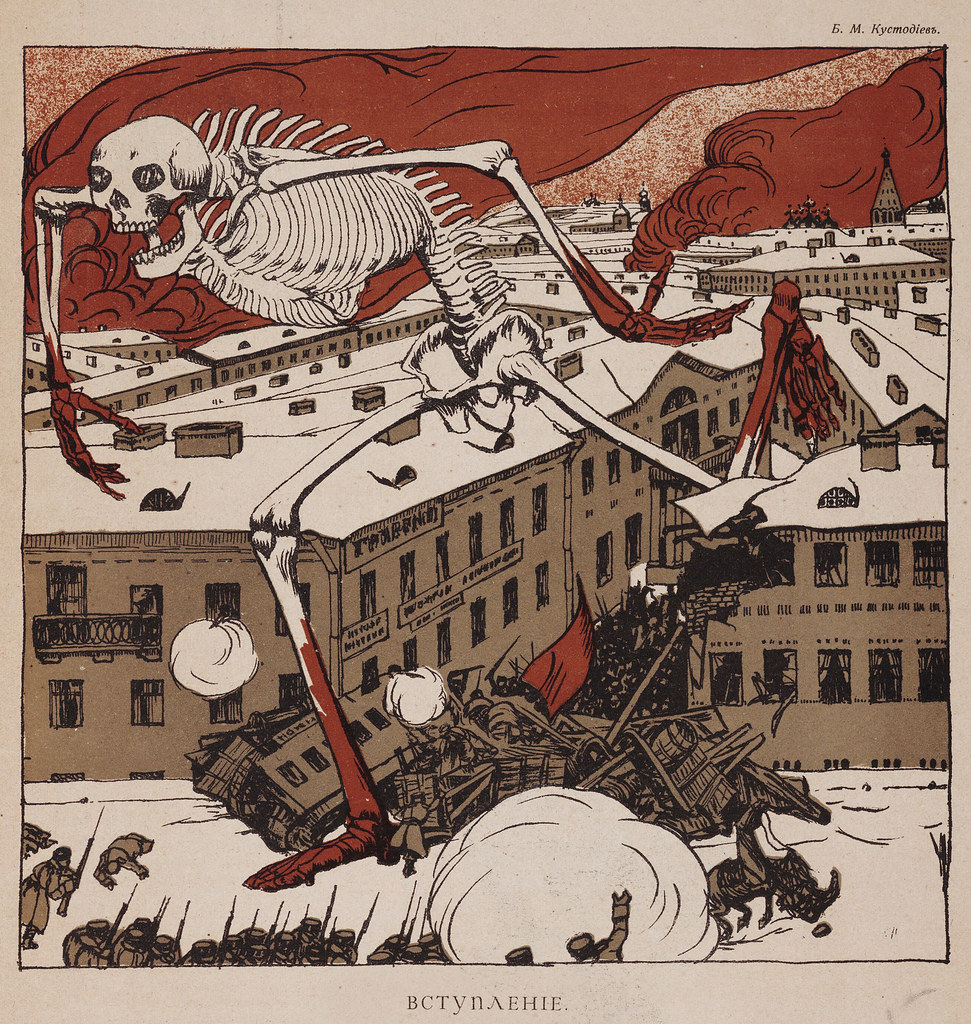







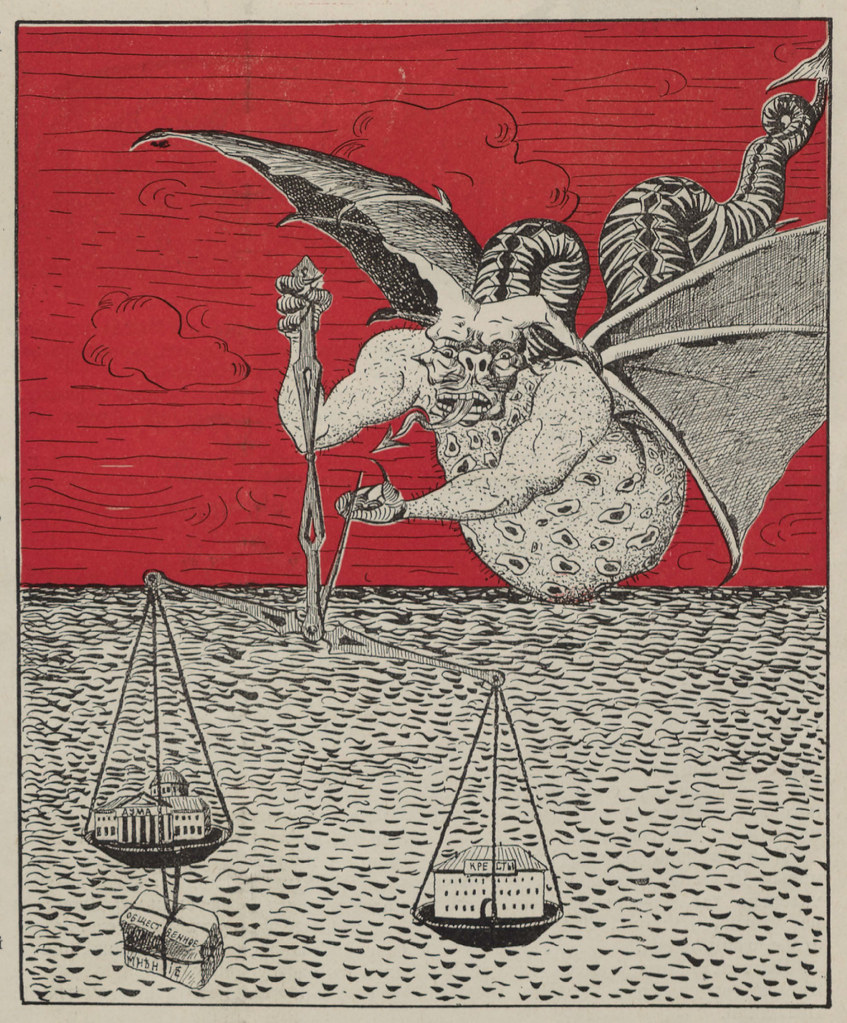
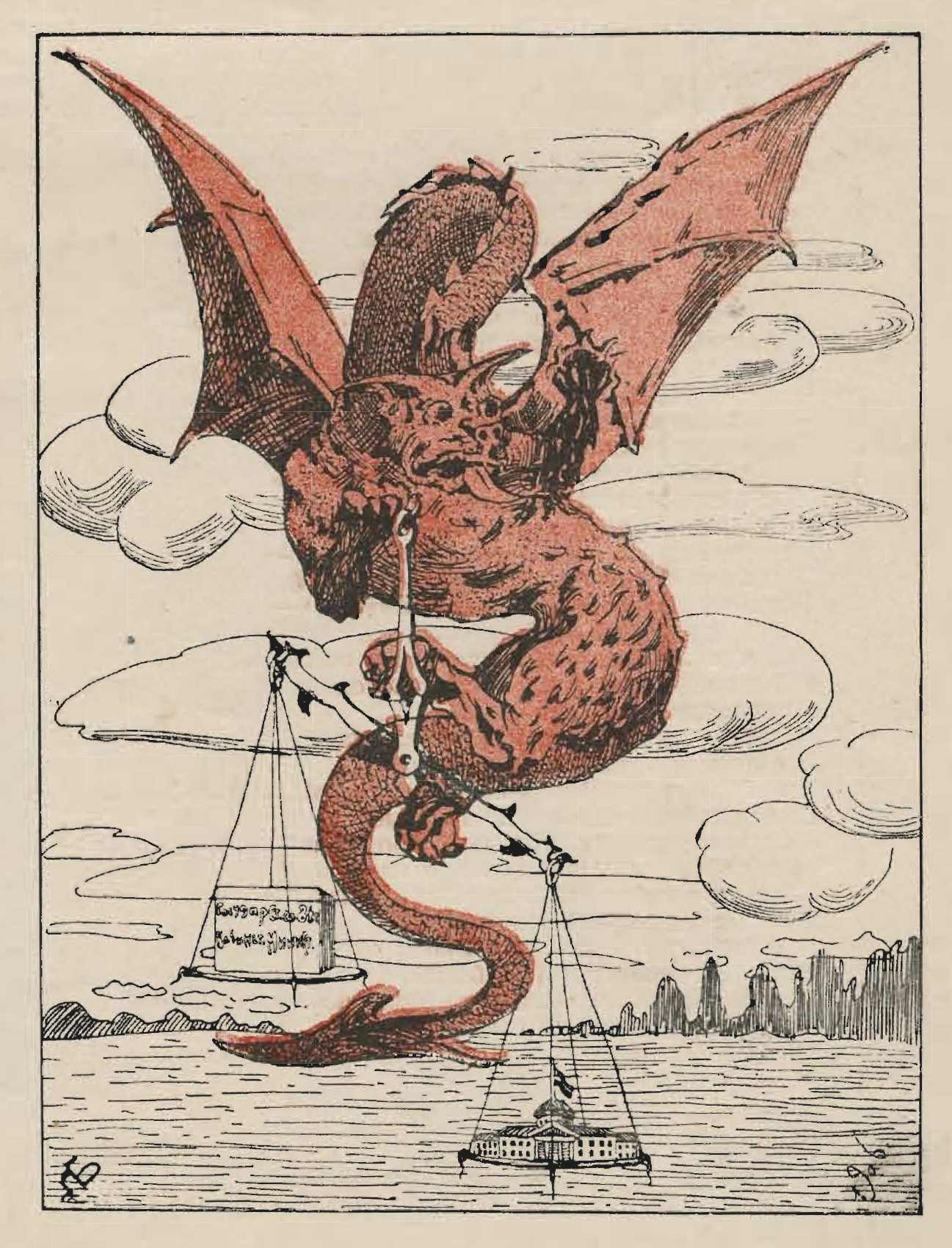






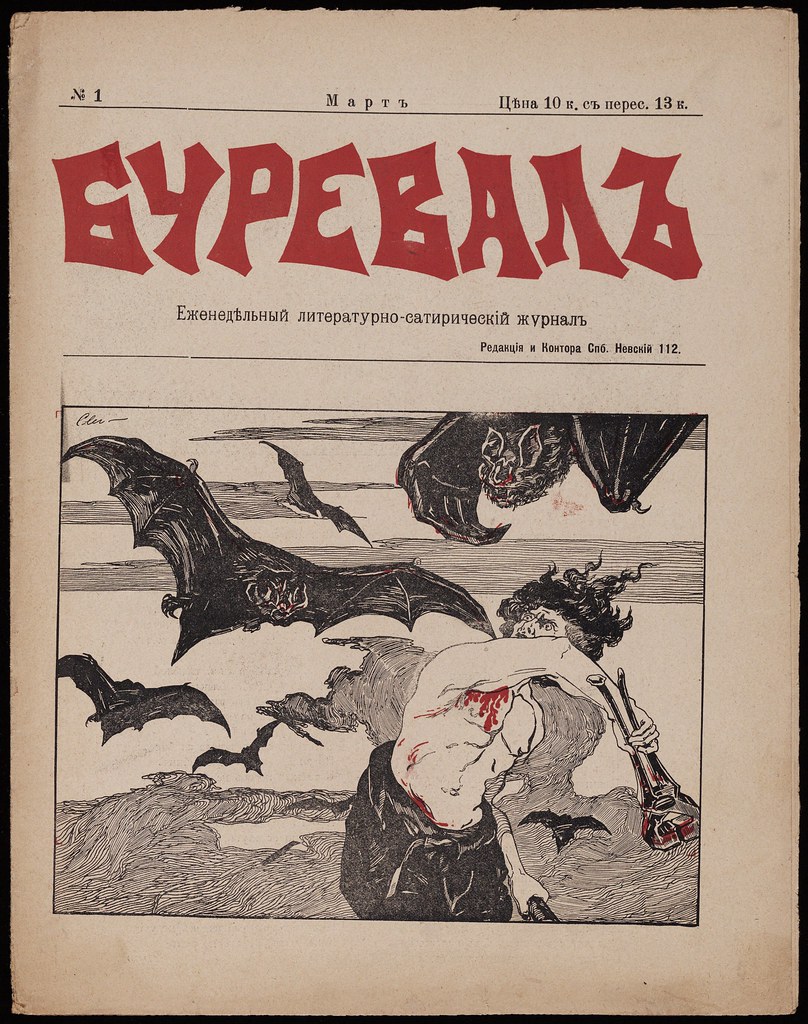



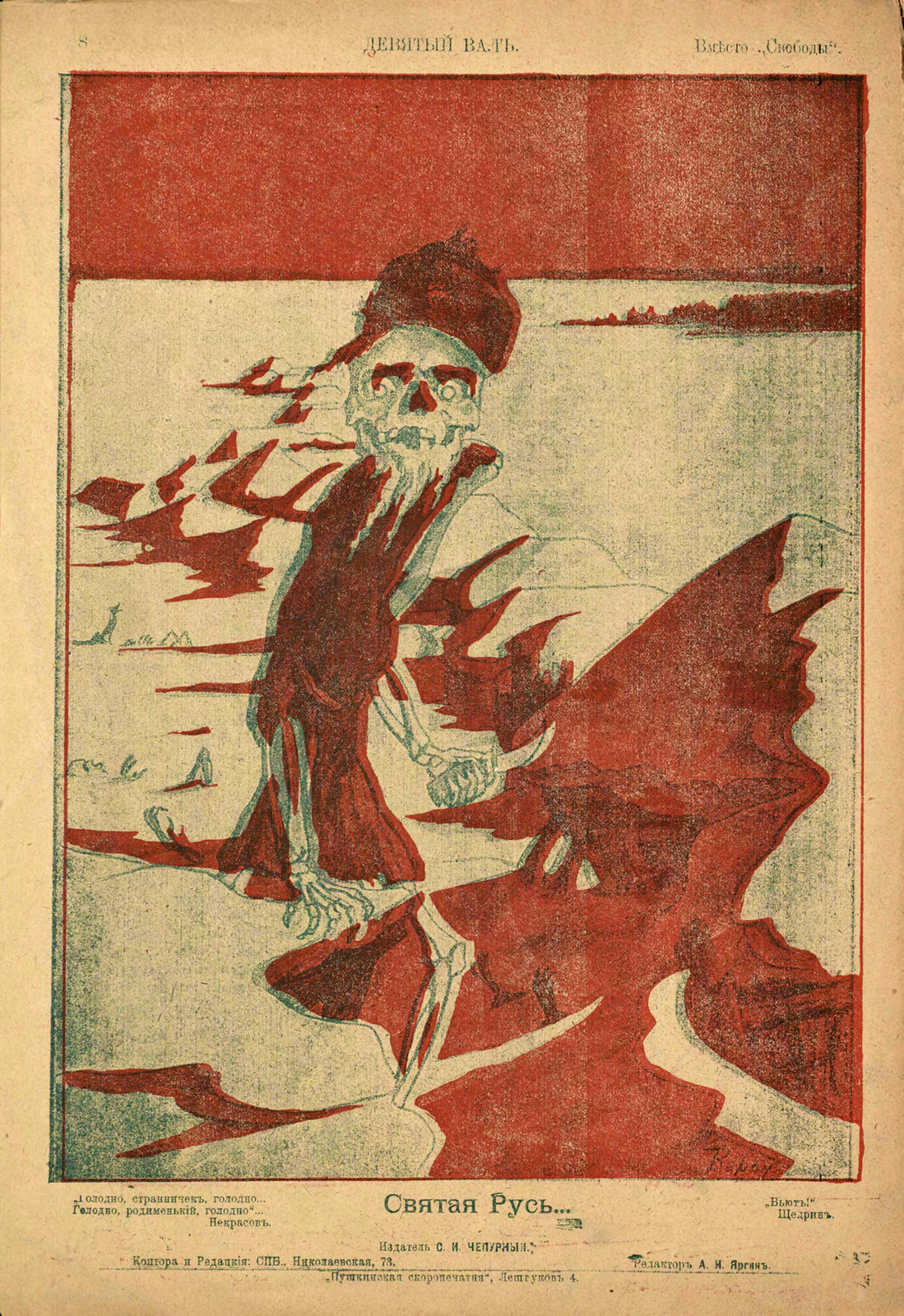

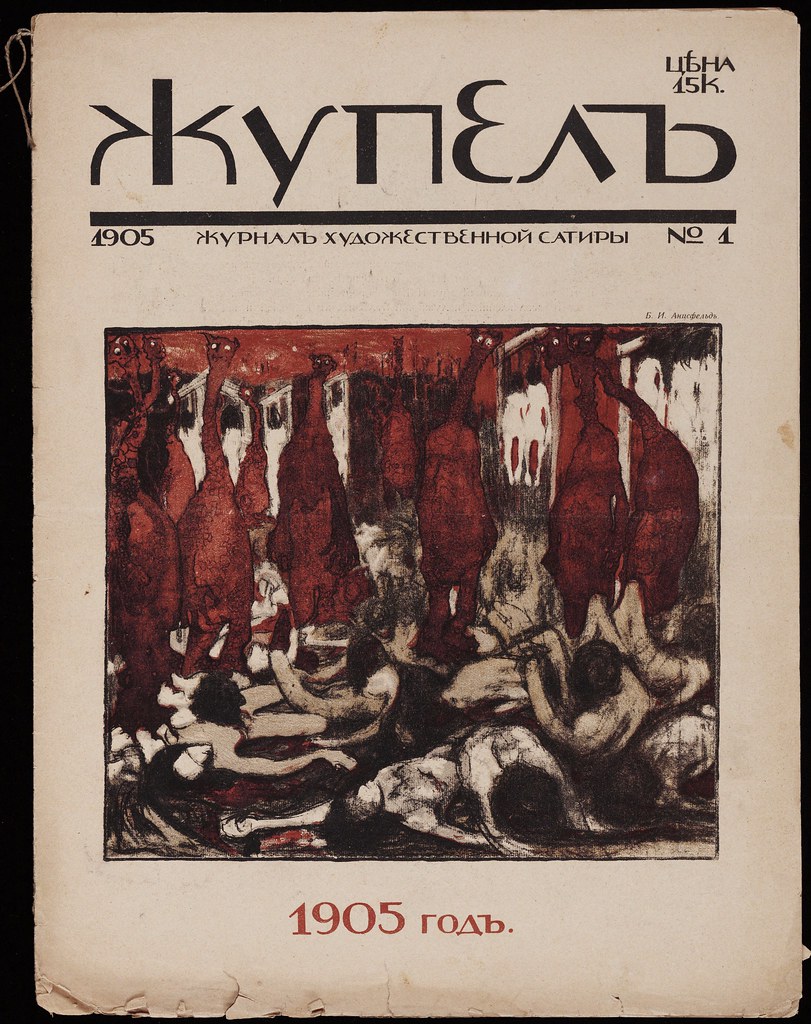




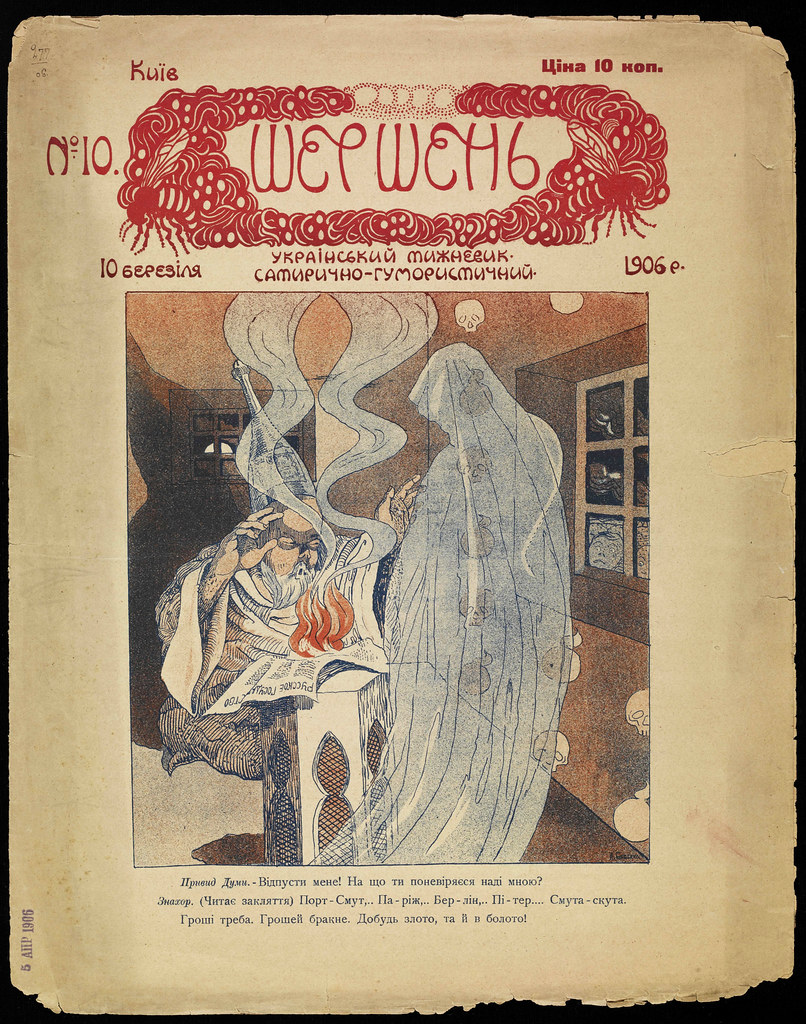
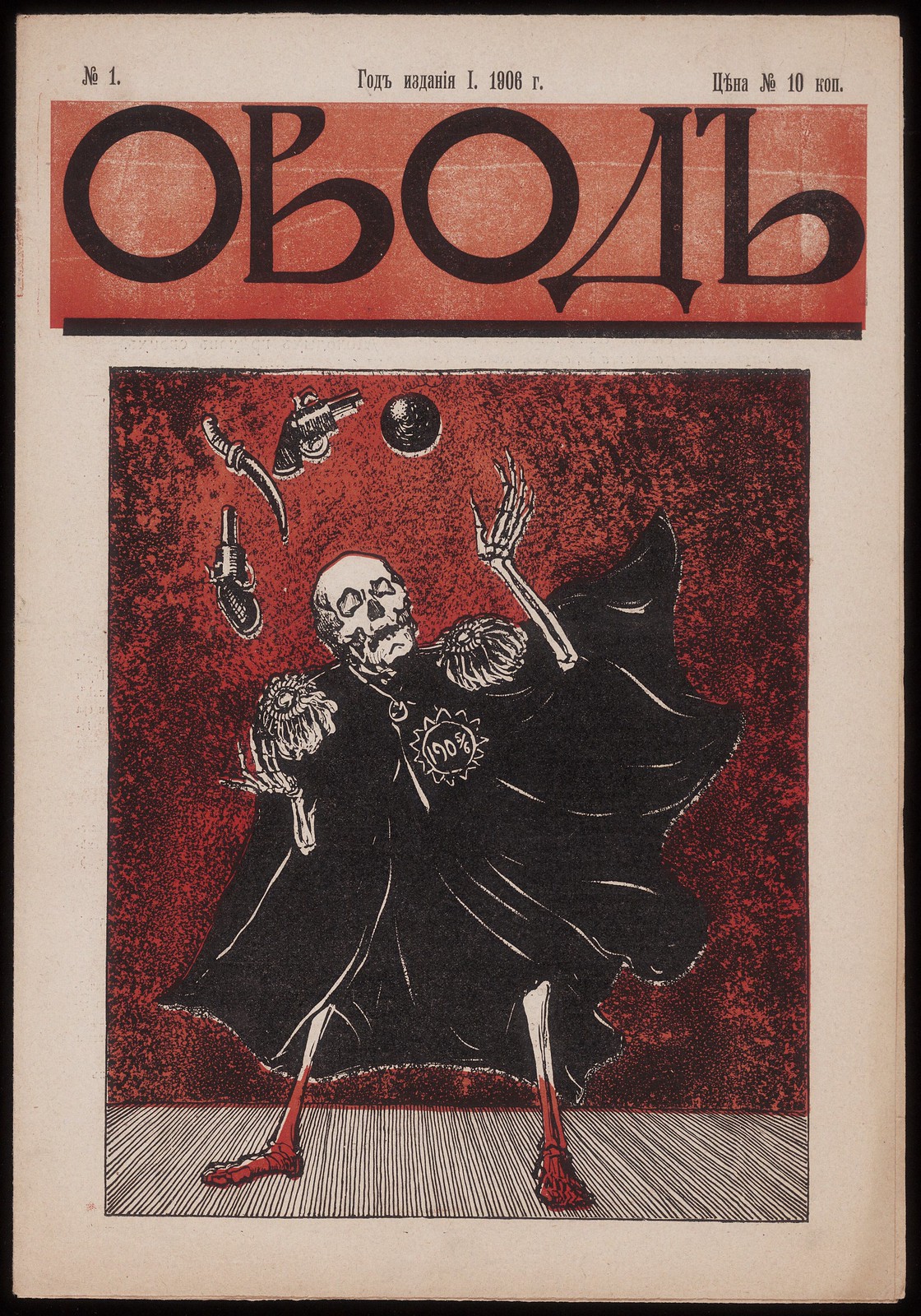

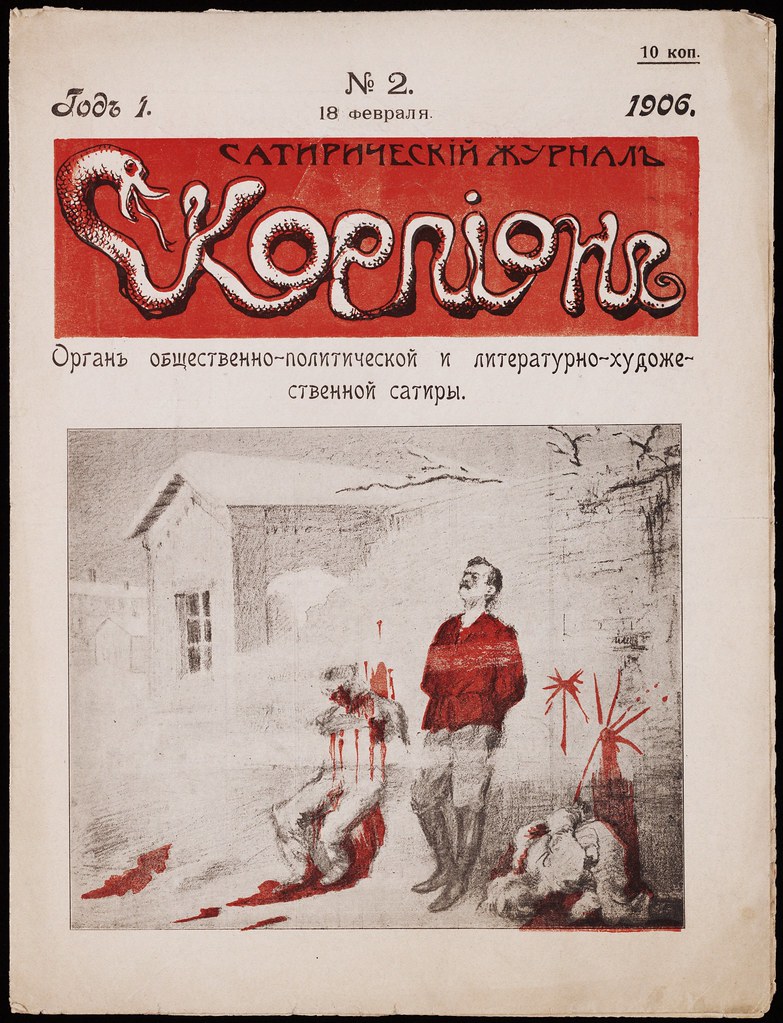

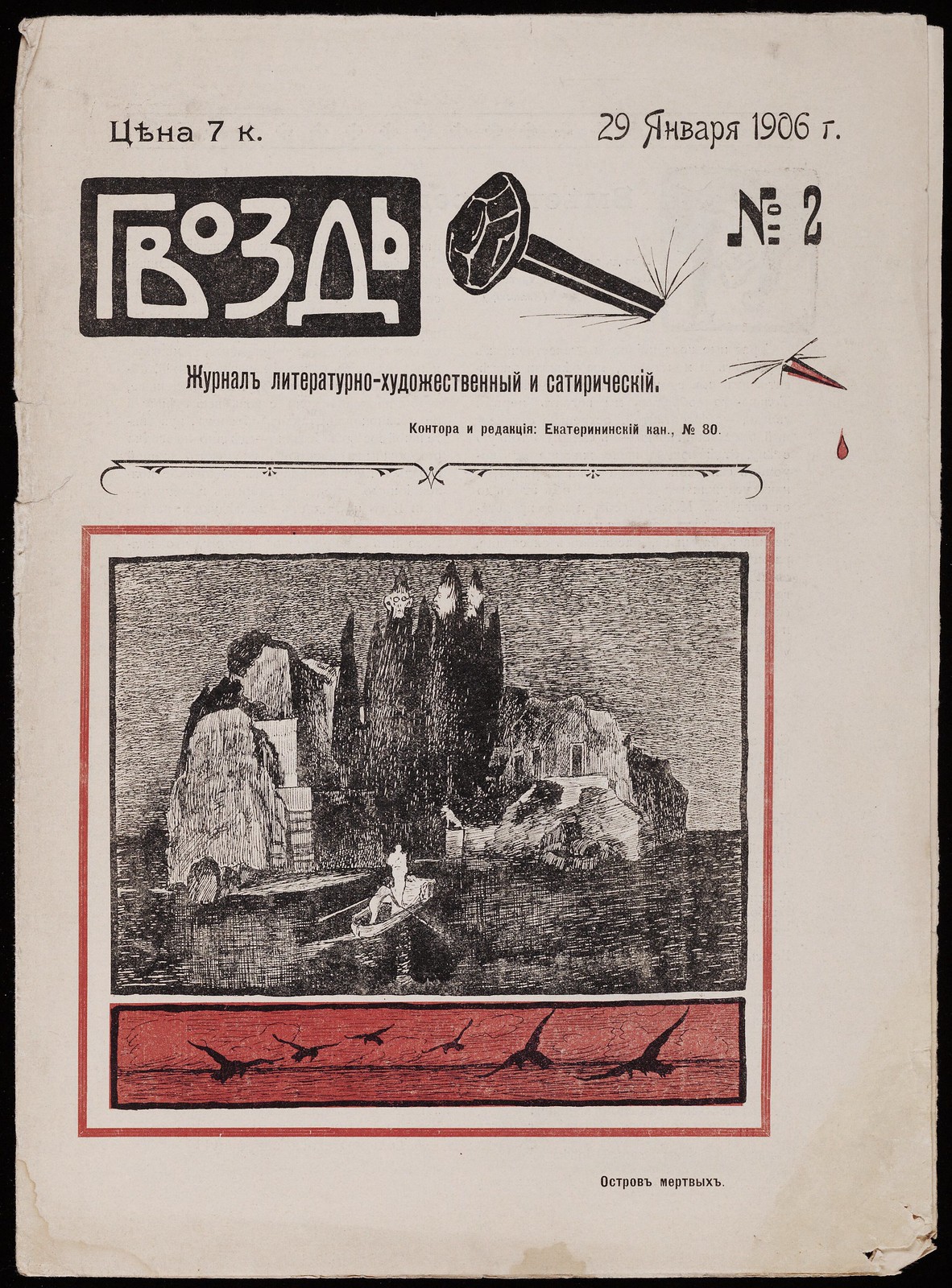






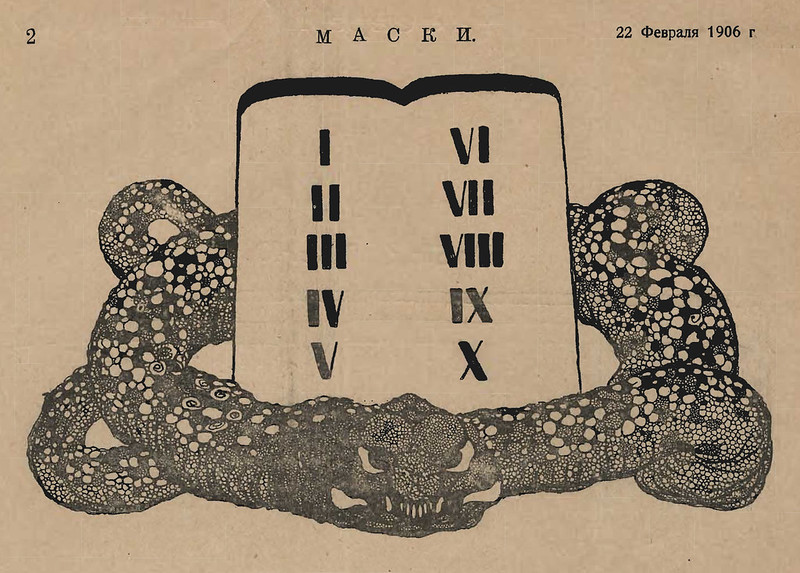



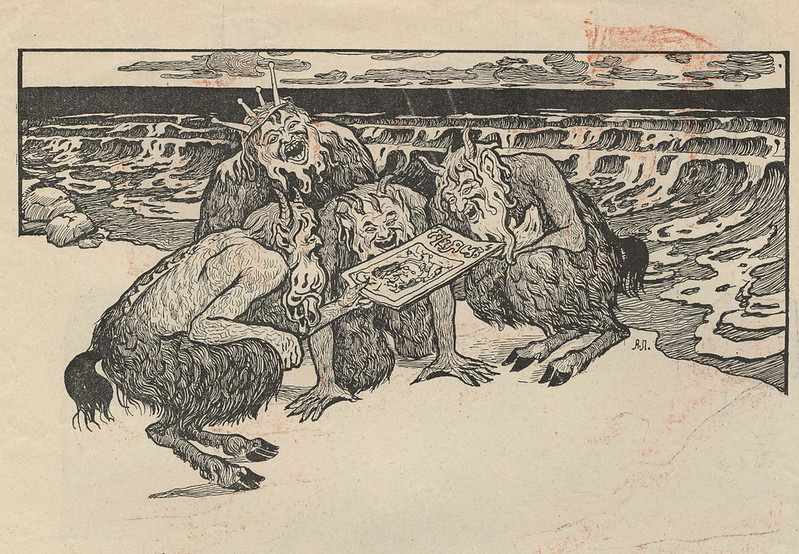









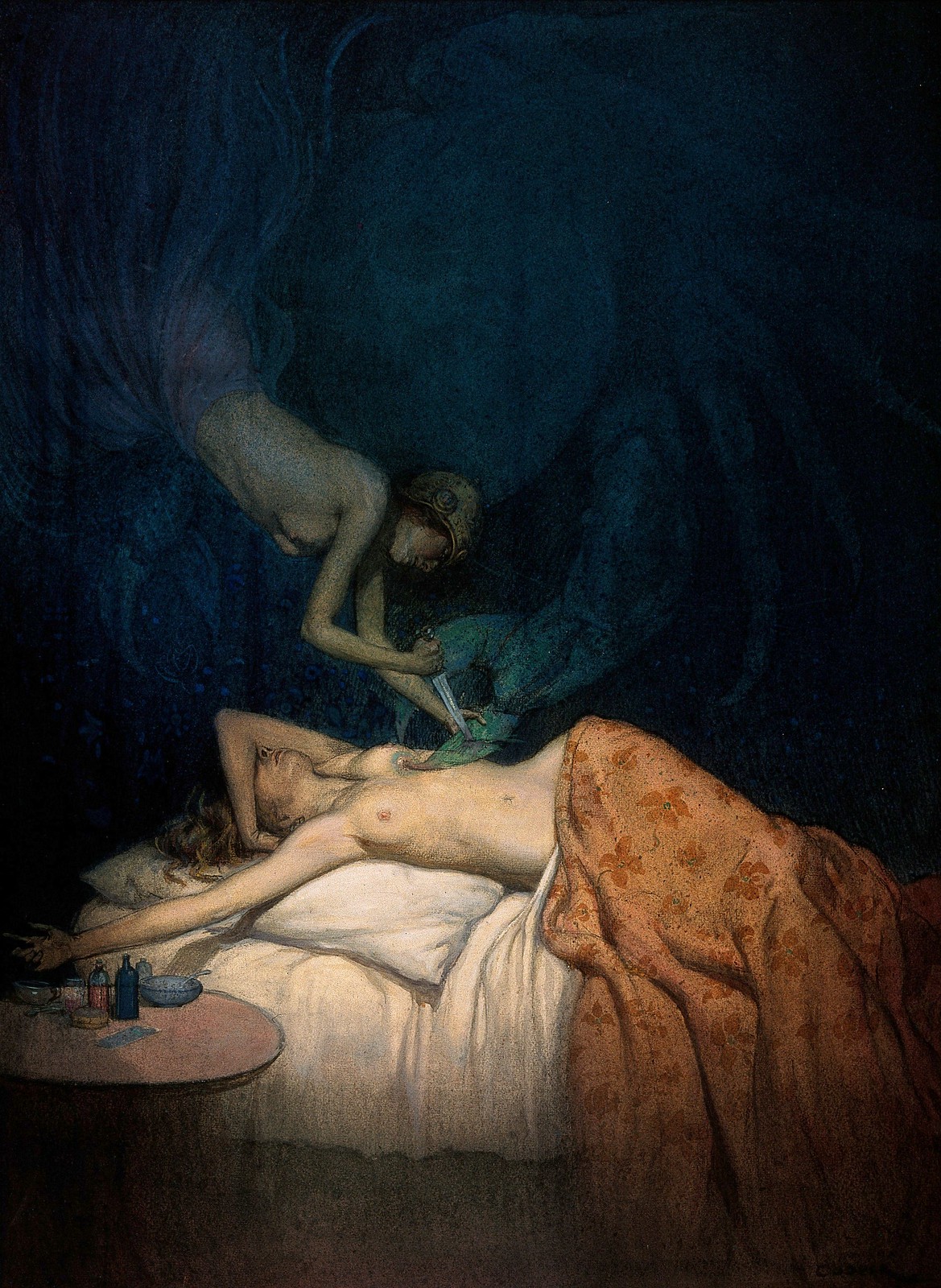


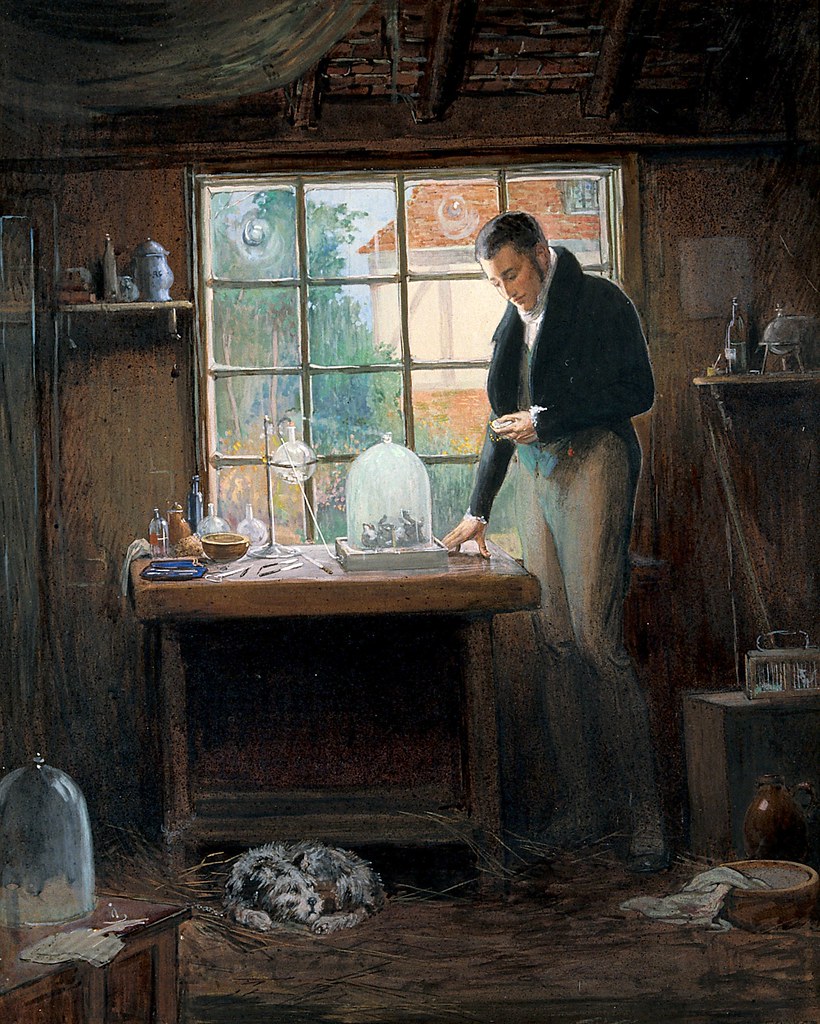


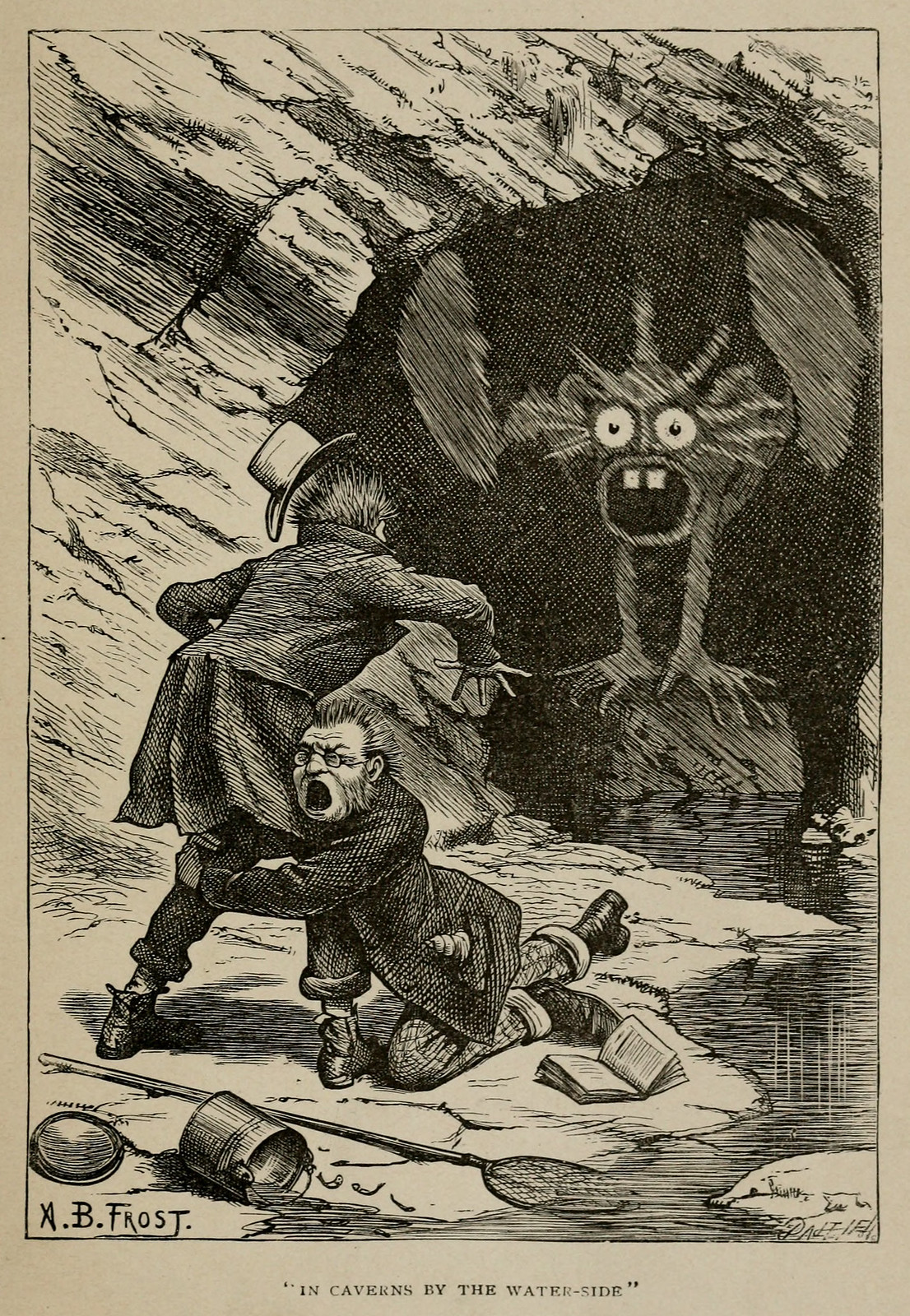






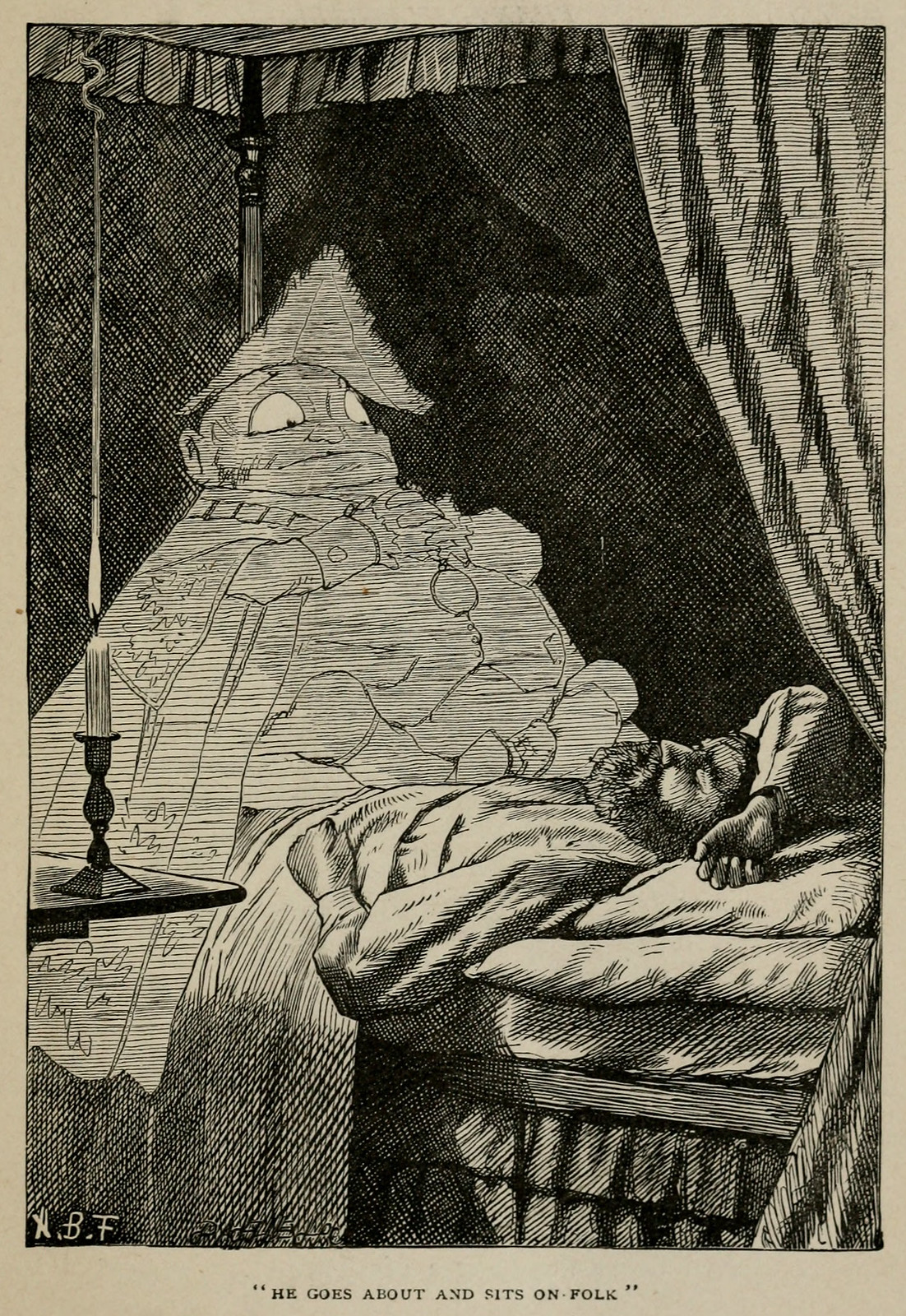

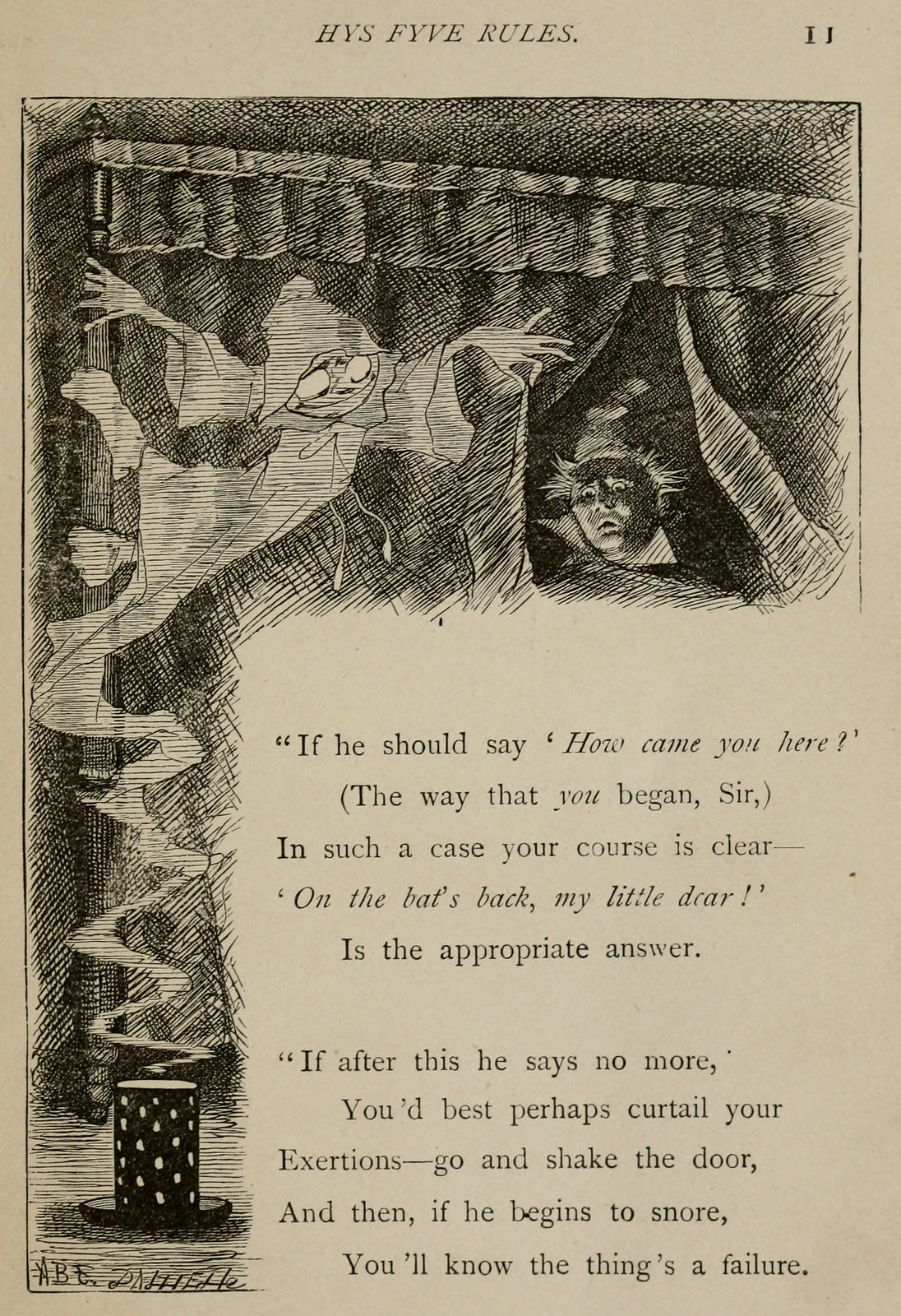

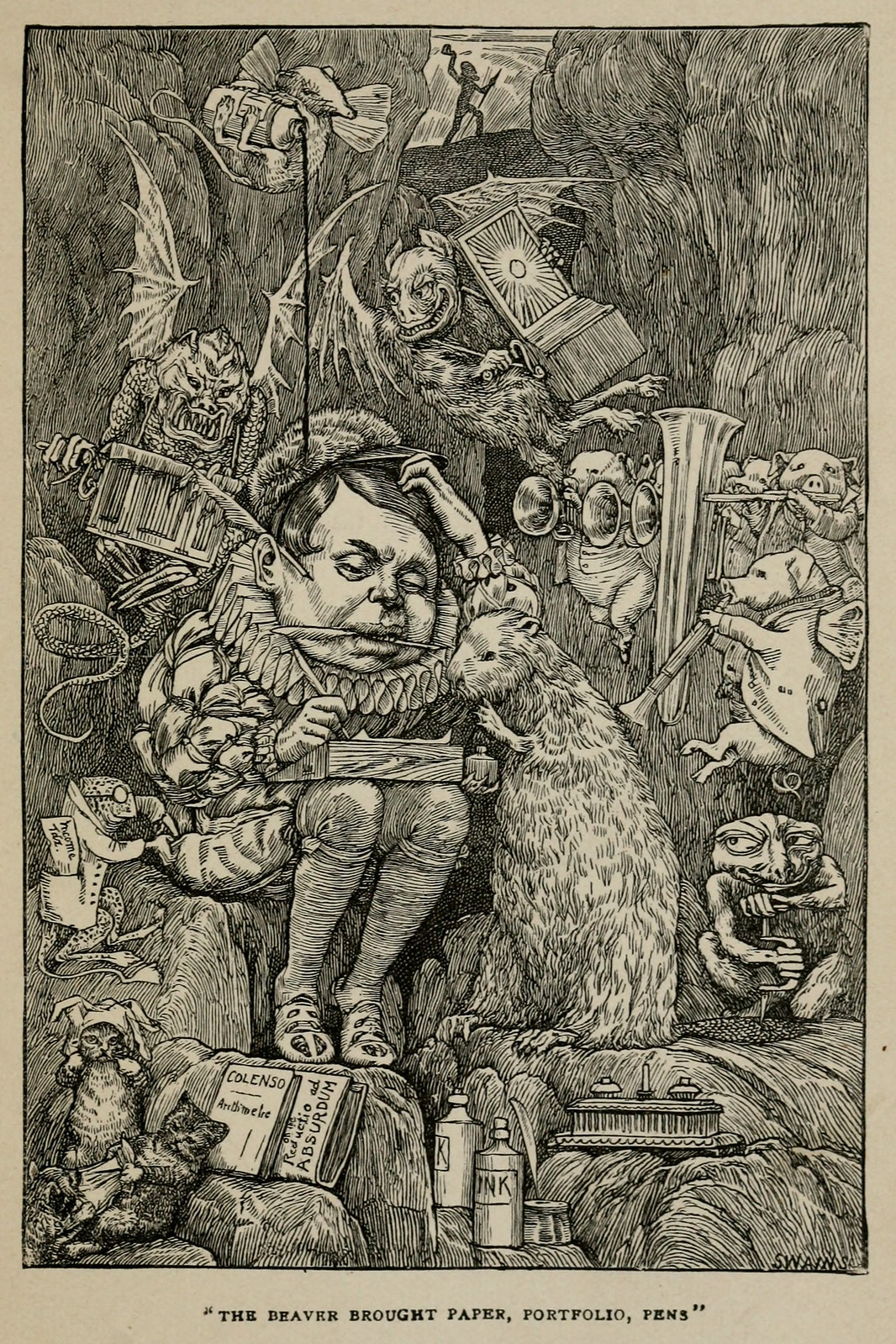















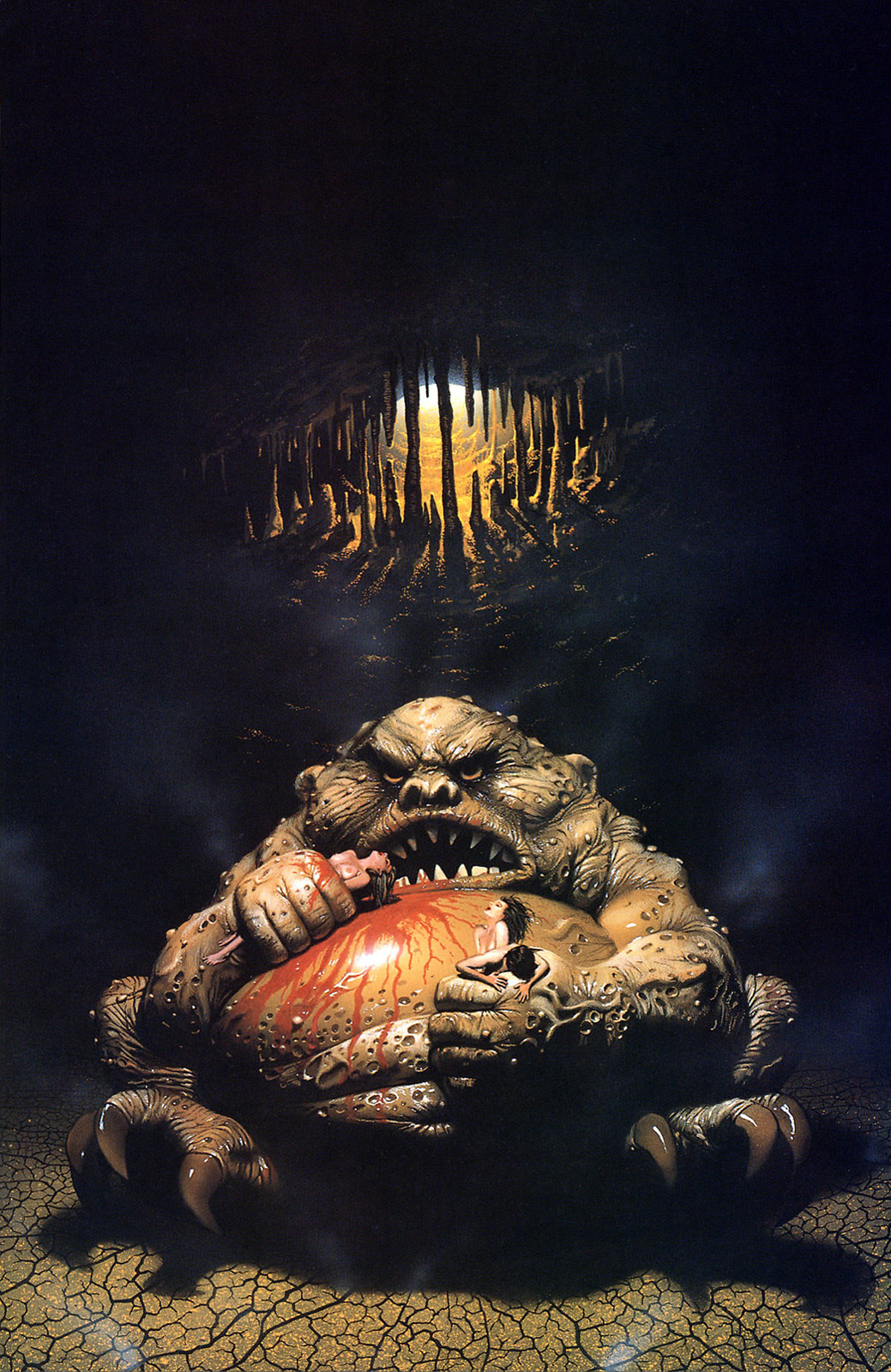



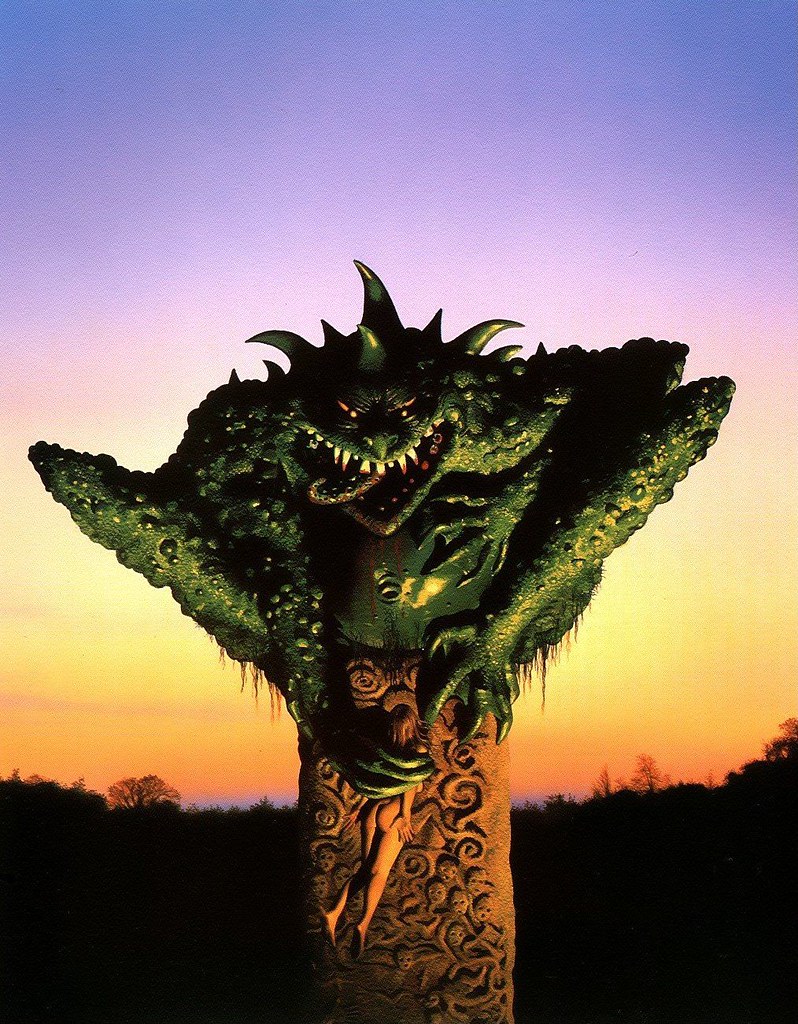



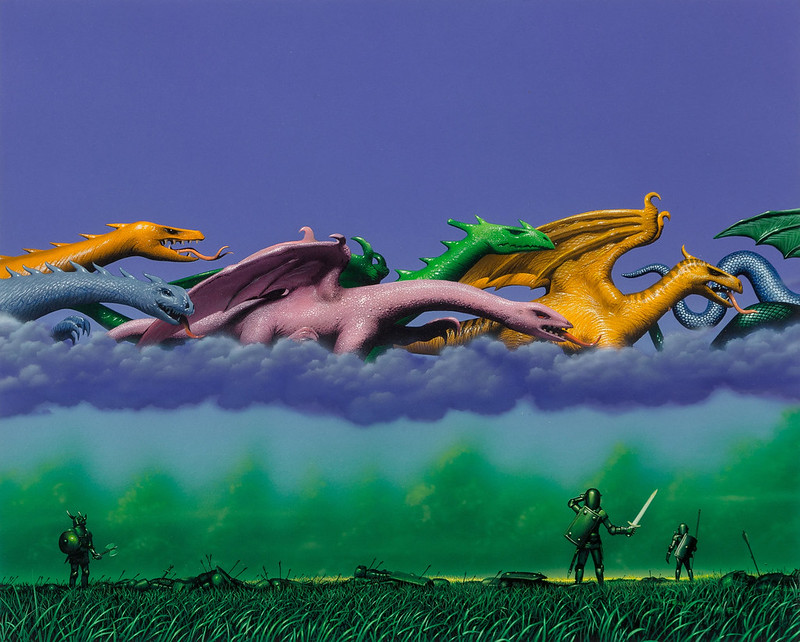






























































































































































































































































































































































































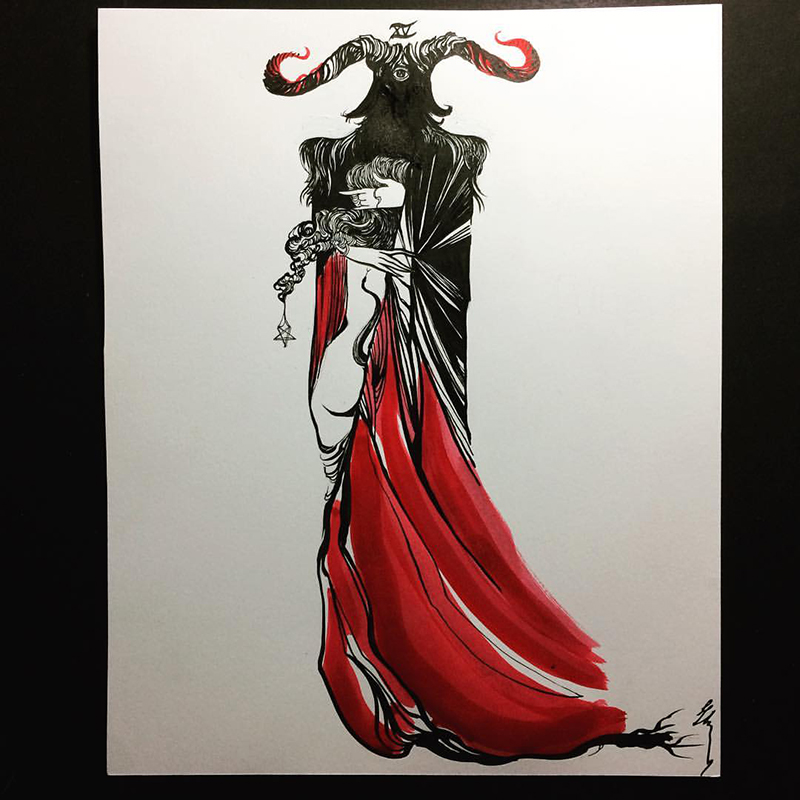





















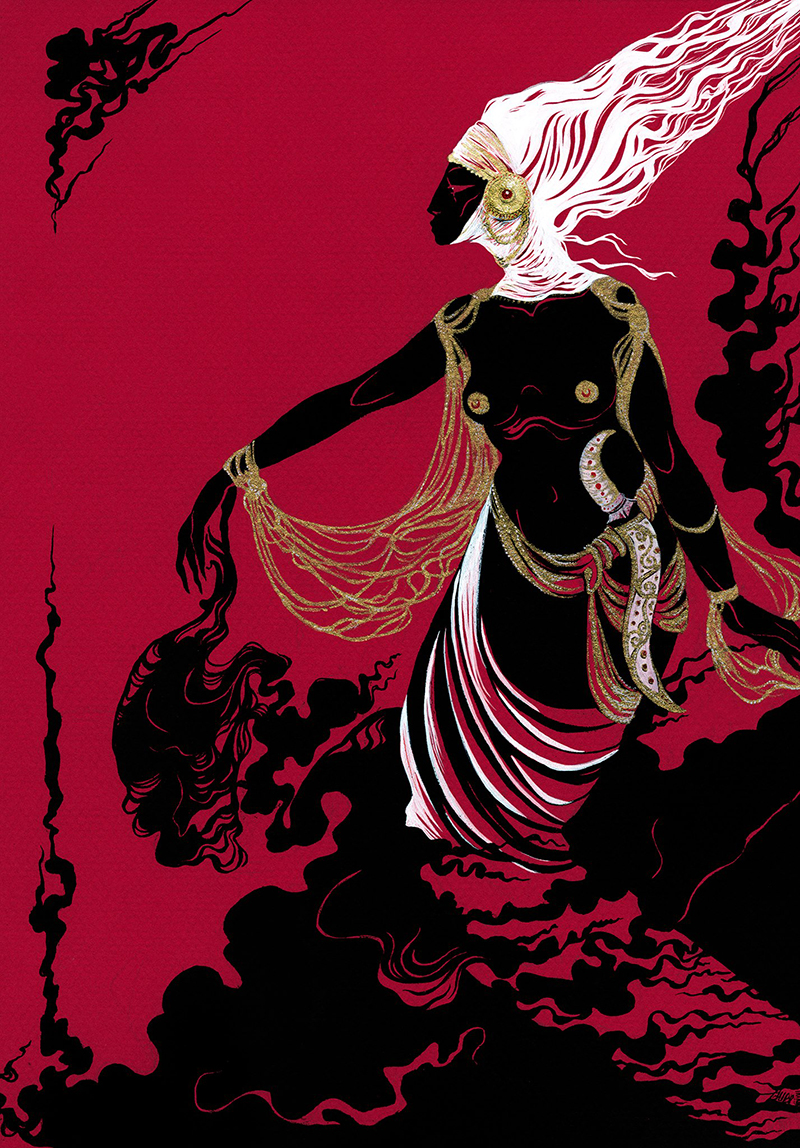



























































































































































































































































































































































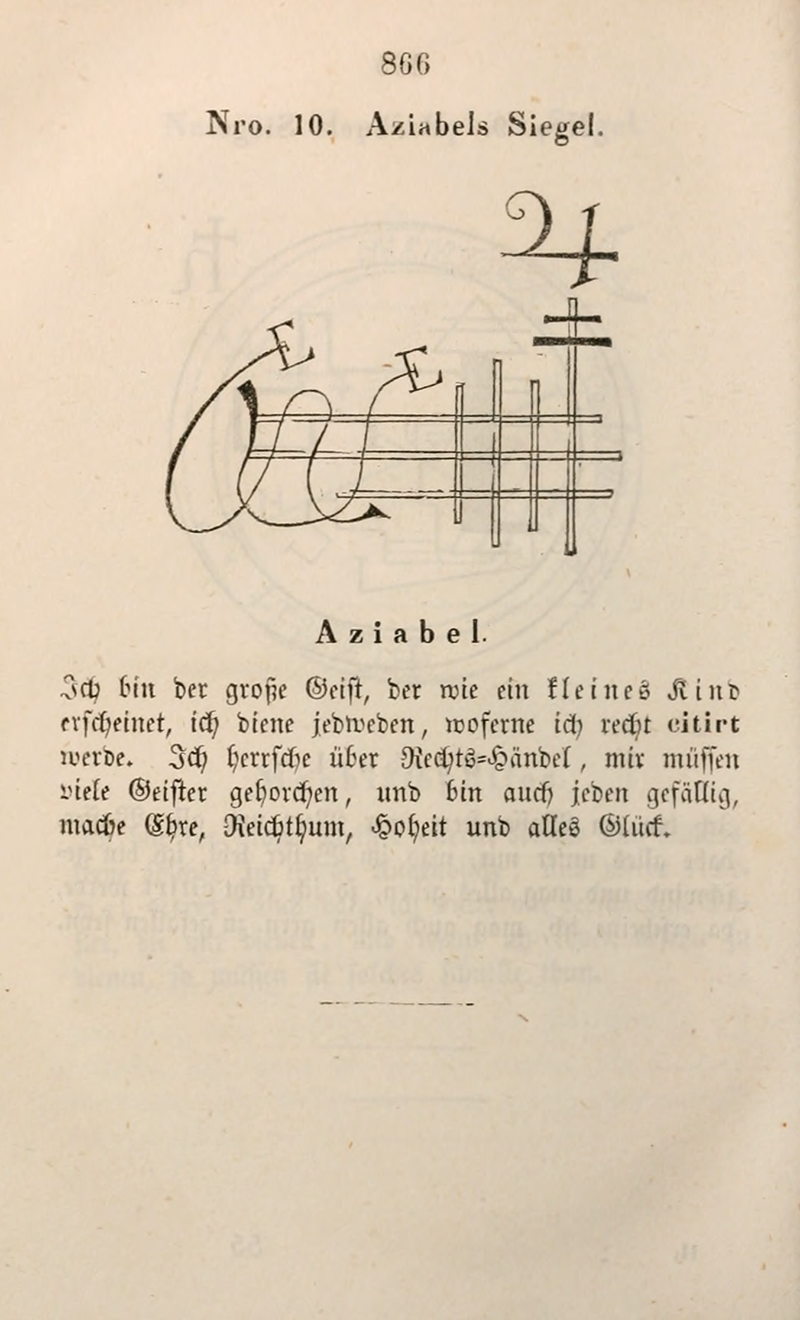


























































































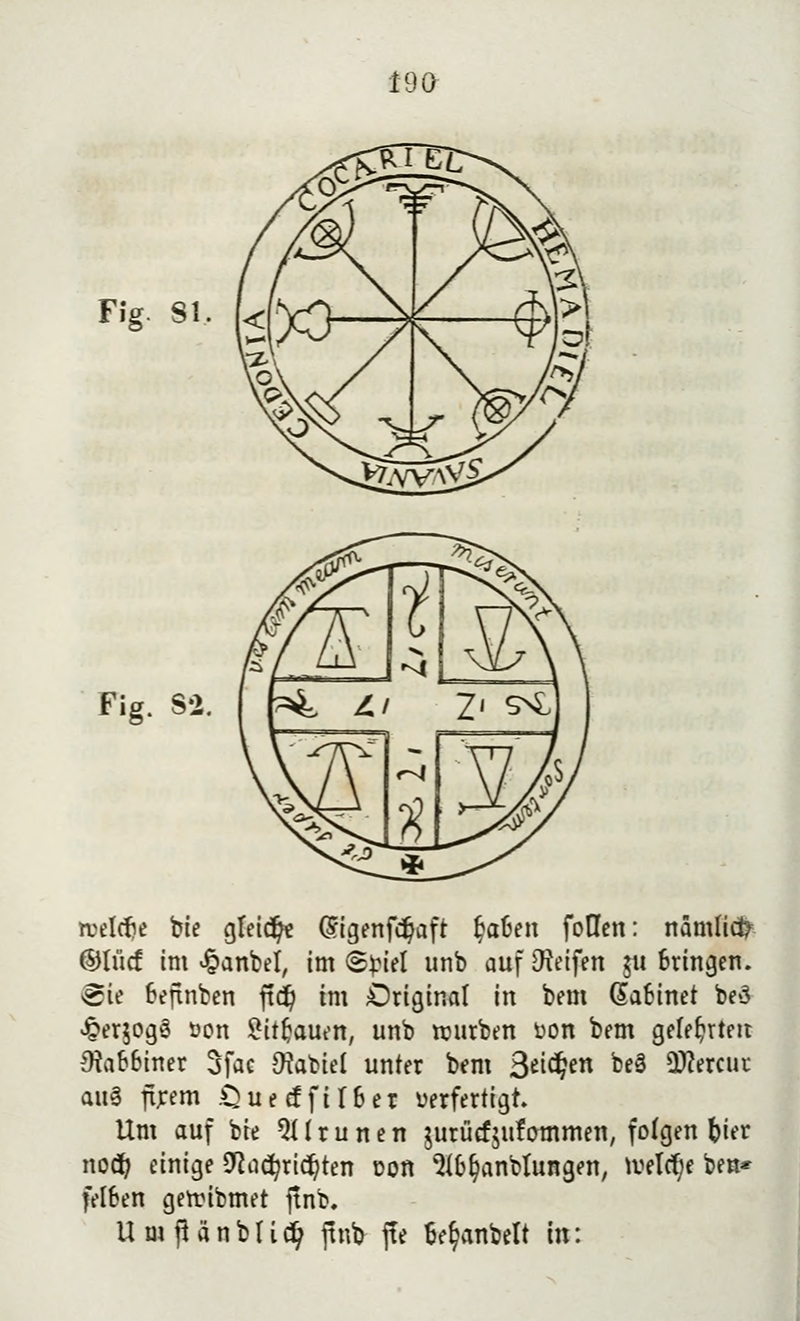






























































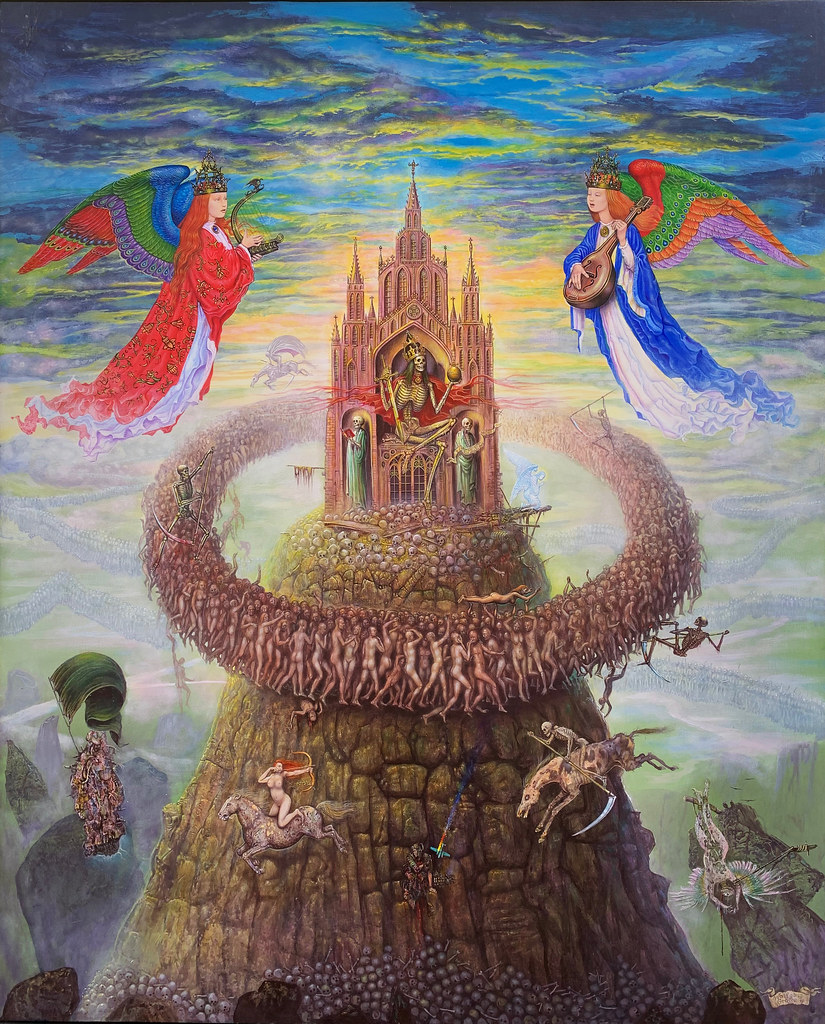




















































































































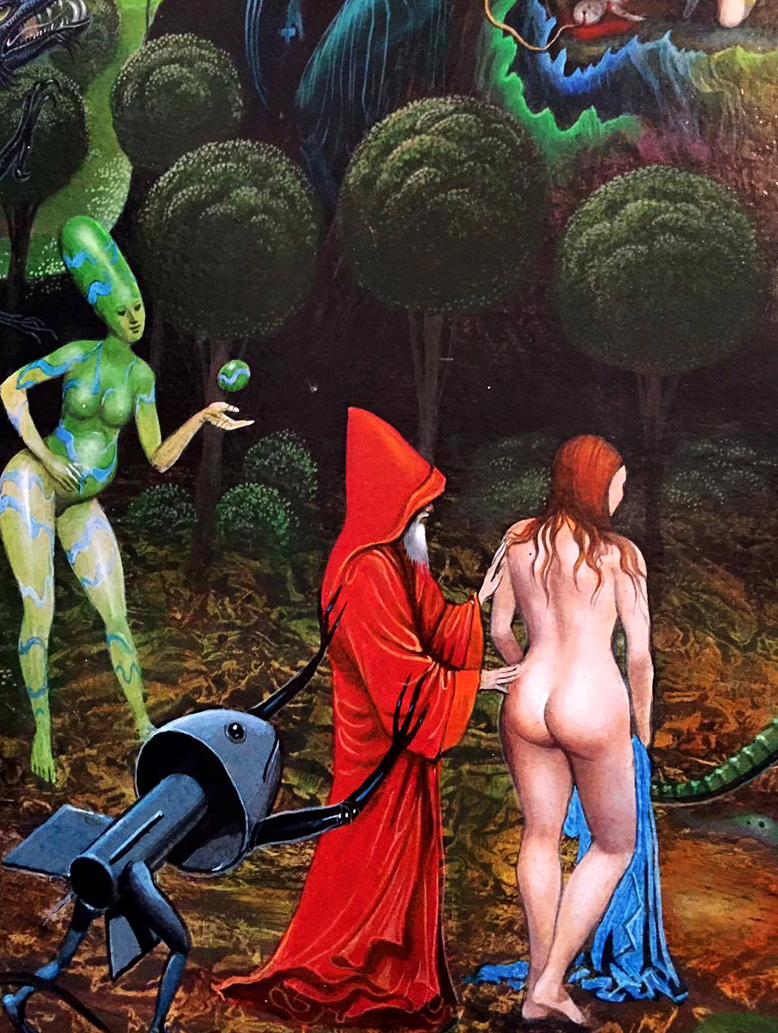

























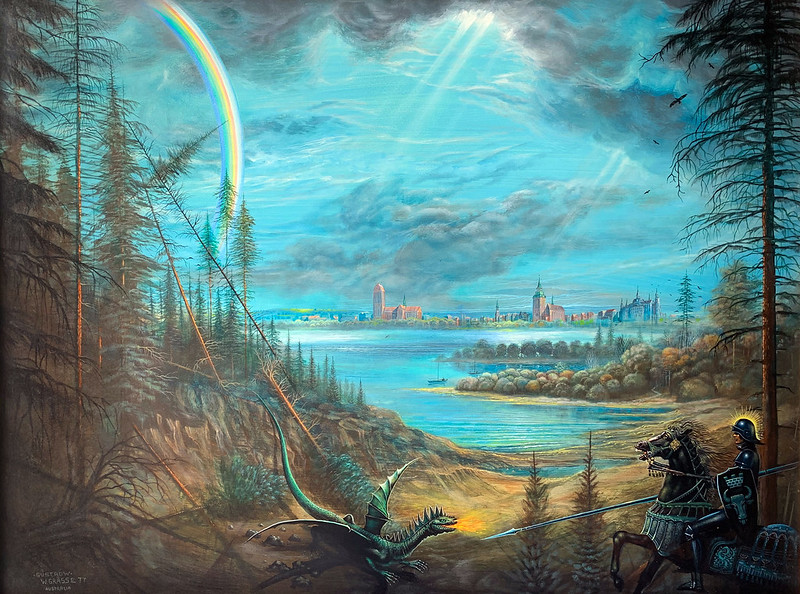



















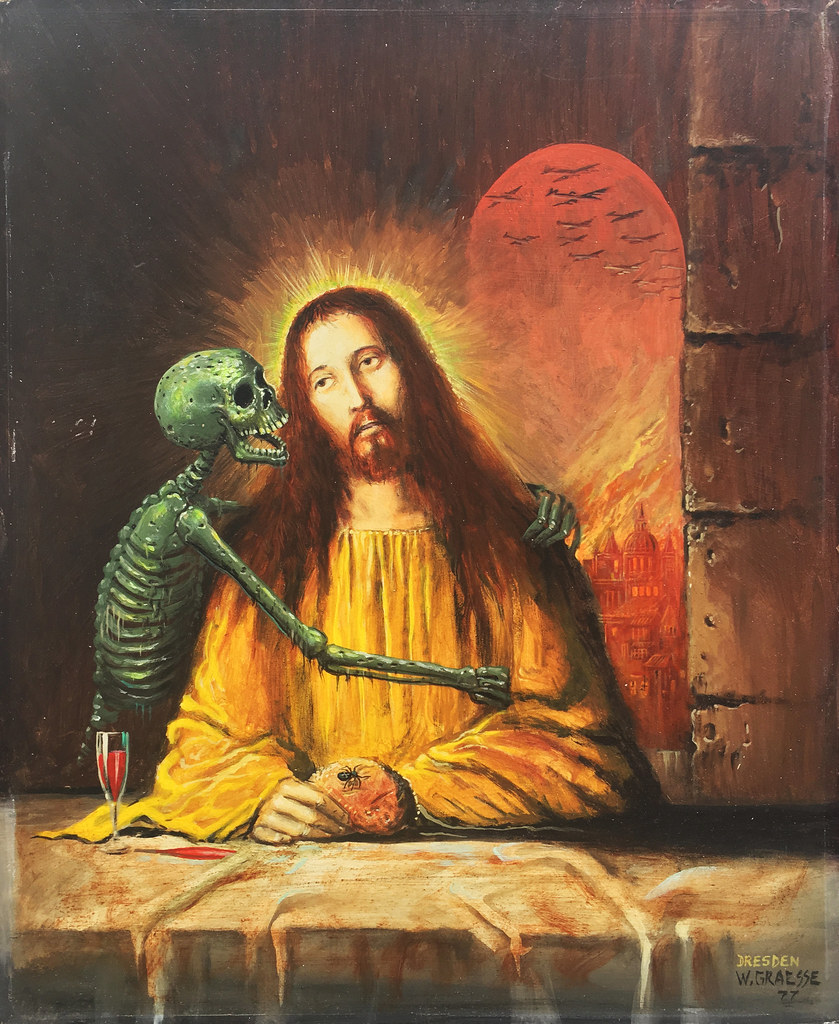










 Hell Attendant II, 2014
Hell Attendant II, 2014






















